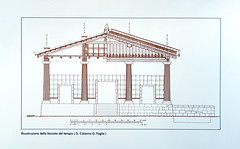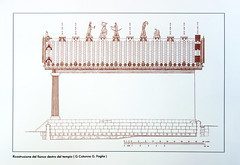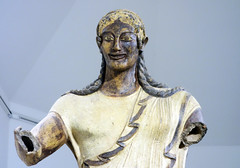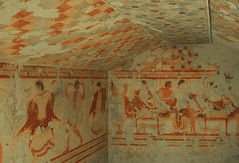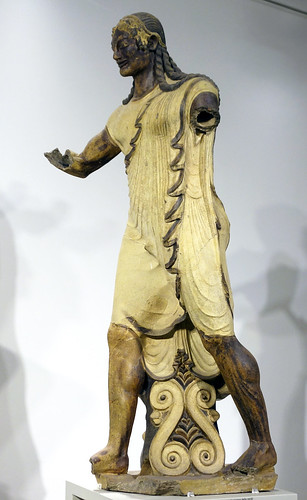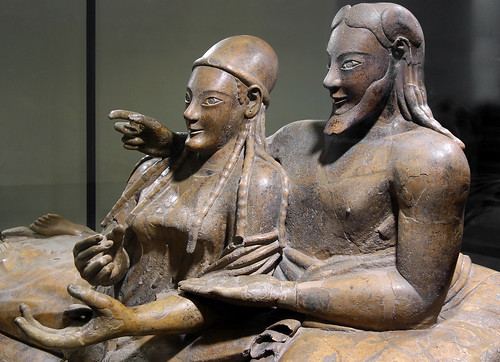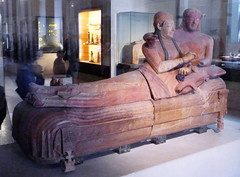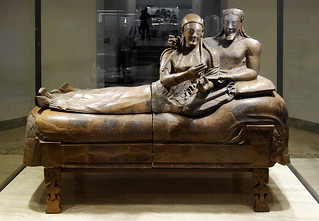2.7: Etruscan
- Page ID
- 63770
\( \newcommand{\vecs}[1]{\overset { \scriptstyle \rightharpoonup} {\mathbf{#1}} } \)
\( \newcommand{\vecd}[1]{\overset{-\!-\!\rightharpoonup}{\vphantom{a}\smash {#1}}} \)
\( \newcommand{\dsum}{\displaystyle\sum\limits} \)
\( \newcommand{\dint}{\displaystyle\int\limits} \)
\( \newcommand{\dlim}{\displaystyle\lim\limits} \)
\( \newcommand{\id}{\mathrm{id}}\) \( \newcommand{\Span}{\mathrm{span}}\)
( \newcommand{\kernel}{\mathrm{null}\,}\) \( \newcommand{\range}{\mathrm{range}\,}\)
\( \newcommand{\RealPart}{\mathrm{Re}}\) \( \newcommand{\ImaginaryPart}{\mathrm{Im}}\)
\( \newcommand{\Argument}{\mathrm{Arg}}\) \( \newcommand{\norm}[1]{\| #1 \|}\)
\( \newcommand{\inner}[2]{\langle #1, #2 \rangle}\)
\( \newcommand{\Span}{\mathrm{span}}\)
\( \newcommand{\id}{\mathrm{id}}\)
\( \newcommand{\Span}{\mathrm{span}}\)
\( \newcommand{\kernel}{\mathrm{null}\,}\)
\( \newcommand{\range}{\mathrm{range}\,}\)
\( \newcommand{\RealPart}{\mathrm{Re}}\)
\( \newcommand{\ImaginaryPart}{\mathrm{Im}}\)
\( \newcommand{\Argument}{\mathrm{Arg}}\)
\( \newcommand{\norm}[1]{\| #1 \|}\)
\( \newcommand{\inner}[2]{\langle #1, #2 \rangle}\)
\( \newcommand{\Span}{\mathrm{span}}\) \( \newcommand{\AA}{\unicode[.8,0]{x212B}}\)
\( \newcommand{\vectorA}[1]{\vec{#1}} % arrow\)
\( \newcommand{\vectorAt}[1]{\vec{\text{#1}}} % arrow\)
\( \newcommand{\vectorB}[1]{\overset { \scriptstyle \rightharpoonup} {\mathbf{#1}} } \)
\( \newcommand{\vectorC}[1]{\textbf{#1}} \)
\( \newcommand{\vectorD}[1]{\overrightarrow{#1}} \)
\( \newcommand{\vectorDt}[1]{\overrightarrow{\text{#1}}} \)
\( \newcommand{\vectE}[1]{\overset{-\!-\!\rightharpoonup}{\vphantom{a}\smash{\mathbf {#1}}}} \)
\( \newcommand{\vecs}[1]{\overset { \scriptstyle \rightharpoonup} {\mathbf{#1}} } \)
\( \newcommand{\vecd}[1]{\overset{-\!-\!\rightharpoonup}{\vphantom{a}\smash {#1}}} \)
\(\newcommand{\avec}{\mathbf a}\) \(\newcommand{\bvec}{\mathbf b}\) \(\newcommand{\cvec}{\mathbf c}\) \(\newcommand{\dvec}{\mathbf d}\) \(\newcommand{\dtil}{\widetilde{\mathbf d}}\) \(\newcommand{\evec}{\mathbf e}\) \(\newcommand{\fvec}{\mathbf f}\) \(\newcommand{\nvec}{\mathbf n}\) \(\newcommand{\pvec}{\mathbf p}\) \(\newcommand{\qvec}{\mathbf q}\) \(\newcommand{\svec}{\mathbf s}\) \(\newcommand{\tvec}{\mathbf t}\) \(\newcommand{\uvec}{\mathbf u}\) \(\newcommand{\vvec}{\mathbf v}\) \(\newcommand{\wvec}{\mathbf w}\) \(\newcommand{\xvec}{\mathbf x}\) \(\newcommand{\yvec}{\mathbf y}\) \(\newcommand{\zvec}{\mathbf z}\) \(\newcommand{\rvec}{\mathbf r}\) \(\newcommand{\mvec}{\mathbf m}\) \(\newcommand{\zerovec}{\mathbf 0}\) \(\newcommand{\onevec}{\mathbf 1}\) \(\newcommand{\real}{\mathbb R}\) \(\newcommand{\twovec}[2]{\left[\begin{array}{r}#1 \\ #2 \end{array}\right]}\) \(\newcommand{\ctwovec}[2]{\left[\begin{array}{c}#1 \\ #2 \end{array}\right]}\) \(\newcommand{\threevec}[3]{\left[\begin{array}{r}#1 \\ #2 \\ #3 \end{array}\right]}\) \(\newcommand{\cthreevec}[3]{\left[\begin{array}{c}#1 \\ #2 \\ #3 \end{array}\right]}\) \(\newcommand{\fourvec}[4]{\left[\begin{array}{r}#1 \\ #2 \\ #3 \\ #4 \end{array}\right]}\) \(\newcommand{\cfourvec}[4]{\left[\begin{array}{c}#1 \\ #2 \\ #3 \\ #4 \end{array}\right]}\) \(\newcommand{\fivevec}[5]{\left[\begin{array}{r}#1 \\ #2 \\ #3 \\ #4 \\ #5 \\ \end{array}\right]}\) \(\newcommand{\cfivevec}[5]{\left[\begin{array}{c}#1 \\ #2 \\ #3 \\ #4 \\ #5 \\ \end{array}\right]}\) \(\newcommand{\mattwo}[4]{\left[\begin{array}{rr}#1 \amp #2 \\ #3 \amp #4 \\ \end{array}\right]}\) \(\newcommand{\laspan}[1]{\text{Span}\{#1\}}\) \(\newcommand{\bcal}{\cal B}\) \(\newcommand{\ccal}{\cal C}\) \(\newcommand{\scal}{\cal S}\) \(\newcommand{\wcal}{\cal W}\) \(\newcommand{\ecal}{\cal E}\) \(\newcommand{\coords}[2]{\left\{#1\right\}_{#2}}\) \(\newcommand{\gray}[1]{\color{gray}{#1}}\) \(\newcommand{\lgray}[1]{\color{lightgray}{#1}}\) \(\newcommand{\rank}{\operatorname{rank}}\) \(\newcommand{\row}{\text{Row}}\) \(\newcommand{\col}{\text{Col}}\) \(\renewcommand{\row}{\text{Row}}\) \(\newcommand{\nul}{\text{Nul}}\) \(\newcommand{\var}{\text{Var}}\) \(\newcommand{\corr}{\text{corr}}\) \(\newcommand{\len}[1]{\left|#1\right|}\) \(\newcommand{\bbar}{\overline{\bvec}}\) \(\newcommand{\bhat}{\widehat{\bvec}}\) \(\newcommand{\bperp}{\bvec^\perp}\) \(\newcommand{\xhat}{\widehat{\xvec}}\) \(\newcommand{\vhat}{\widehat{\vvec}}\) \(\newcommand{\uhat}{\widehat{\uvec}}\) \(\newcommand{\what}{\widehat{\wvec}}\) \(\newcommand{\Sighat}{\widehat{\Sigma}}\) \(\newcommand{\lt}{<}\) \(\newcommand{\gt}{>}\) \(\newcommand{\amp}{&}\) \(\definecolor{fillinmathshade}{gray}{0.9}\)Etruscan
A brilliant culture once controlled almost the entire peninsula we now call Italy. This was the Etruscan civilization.
c. 800 - 500 B.C.E.
The Etruscans, an introduction

Before the small village of Rome became “Rome” with a capital R (to paraphrase D.H. Lawrence), a brilliant civilization once controlled almost the entire peninsula we now call Italy. This was the Etruscan civilization, a vanished culture whose achievements set the stage not only for the development of ancient Roman art and culture but for the Italian Renaissance as well.
Though you may not have heard of them, the Etruscans were the first “superpower” of the Western Mediterranean who, alongside the Greeks, developed the earliest true cities in Europe. They were so successful, in fact, that the most important cities in modern Tuscany (Florence, Pisa, and Siena, to name a few) were first established by the Etruscans and have been continuously inhabited since then.
Yet the labels “mysterious” or “enigmatic” are often attached to the Etruscans since none of their own histories or literature survives. This is particularly ironic as it was the Etruscans who were responsible for teaching the Romans the alphabet and for spreading literacy throughout the Italian peninsula.
The influence on ancient Rome
Etruscan influence on ancient Roman culture was profound. It was from the Etruscans that the Romans inherited many of their own cultural and artistic traditions, from the spectacle of gladiatorial combat, to hydraulic engineering, temple design, and religious ritual, among many other things. In fact, hundreds of years after the Etruscans had been conquered by the Romans and absorbed into their empire, the Romans still maintained an Etruscan priesthood in Rome (which they thought necessary to consult when under attack from invading “barbarians”).
We even derive our very common word “person’” from the Etruscan mythological figure Phersu — the frightful, masked figure you see in this Early Etruscan tomb painting who would engage his victims in a dreadful “game” of blood letting in order to appease the soul of the deceased (the original gladiatorial games, according to the Romans!).
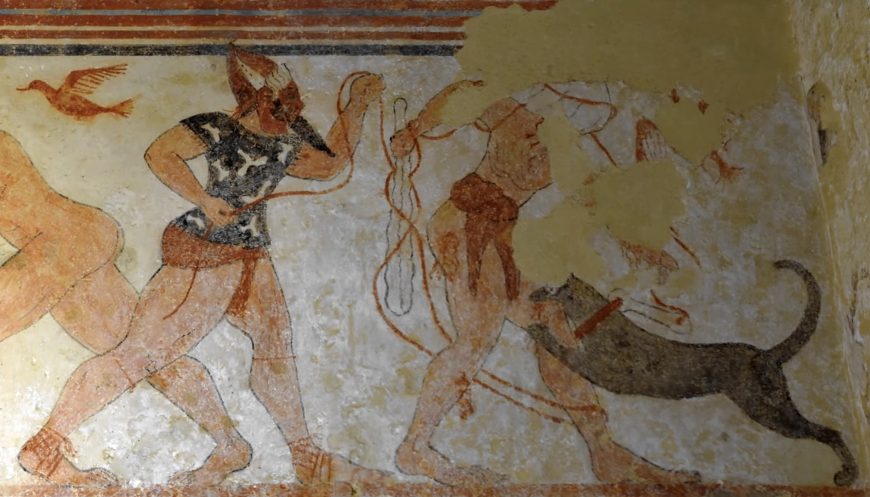
Etruscan art and the afterlife
Early on the Etruscans developed a vibrant artistic and architectural culture, one that was often in dialogue with other Mediterranean civilizations. Trading of the many natural mineral resources found in Tuscany, the center of ancient Etruria, caused them to bump up against Greeks, Phoenicians and Egyptians in the Mediterranean. With these other Mediterranean cultures, they exchanged goods, ideas and, often, a shared artistic vocabulary.
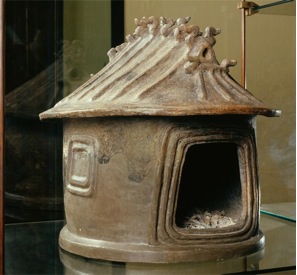
Unlike with the Greeks, however, the majority of our knowledge about Etruscan art comes largely from their burials. (Since most Etruscan cities are still inhabited, they hide their Etruscan art and architecture under Roman, Medieval and Renaissance layers). Fortunately, though, the Etruscans cared very much about equipping their dead with everything necessary for the afterlife—from lively tomb paintings to sculpture to pottery that they could use in the next world.
From their extensive cemeteries, we can look at the “world of the dead” and begin to understand some about the “world of the living.” During the early phases of Etruscan civilization, they conceived of the afterlife in terms of life as they knew it. When someone died, he or she would be cremated and provided with another ‘home’ for the afterlife.
This type of hut urn (above left), made of an unrefined clay known as impasto, would be used to house the cremated remains of the deceased. Not coincidentally, it shows us in miniature form what a typical Etruscan house would have looked like in Iron Age Etruria (900-750 B.C.E.)—oval with a timber roof and a smoke hole for an internal hearth.
More opulent tombs
Later on, houses for the dead became much more elaborate. During the Orientalizing period (750-575 B.C.E.), when the Etruscans began to trade their natural resources with other Mediterranean cultures and became staggeringly wealthy as a result, their tombs became more and more opulent.
The well-known Regolini-Galassi tomb from the city of Cerveteri shows how this new wealth transformed the modest hut to an extravagant house for the dead. Built for a woman clearly of high rank, the massive stone tomb contains a long corridor with lateral, oval rooms leading to a main chamber.
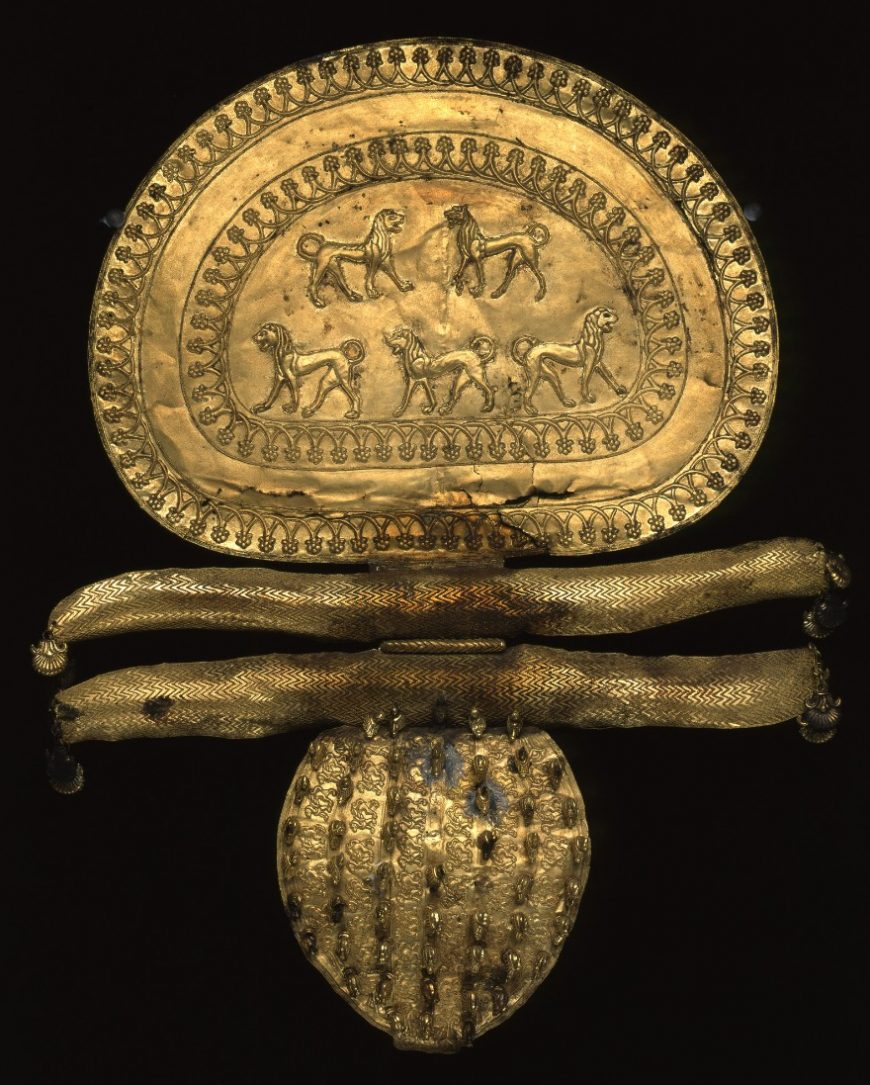
A stroll through the Etruscan rooms in the Vatican museum where the tomb artifacts are now housed presents a mind-boggling view of the enormous wealth of the period. Found near the woman were objects of various precious materials intended for personal adornment in the afterlife—a gold pectoral, gold bracelets, a gold brooch (or fibula) of outsized proportions, among other objects—as well as silver and bronze vessels and numerous other grave goods and furniture.
A bronze bed

Of course, this important woman might also need her four-wheeled bronze-sheathed carriage in the afterlife as well as an incense burner, jewelry of amber and ivory, and, touchingly, her bronze bed around which thirty-three figurines, all in various gestures of mourning, were arranged.
Though later periods in Etruscan history are not characterized by such wealth, the Etruscans were, nevertheless, extremely powerful and influential and left a lasting imprint on the city of Rome and other parts of Italy.
Video \(\PageIndex{1}\): Bettini Tomb in Tarquinia and virtual restoration of its frescoes using archive material
Additional resources:
Video: Etruscan Necropolises of Cerveteri and Tarquinia (from UNESCO/NHK)
“Etruscan art” on The Metropolitan Museum of Art’s Heilbrunn Timeline of Art History
Bucchero
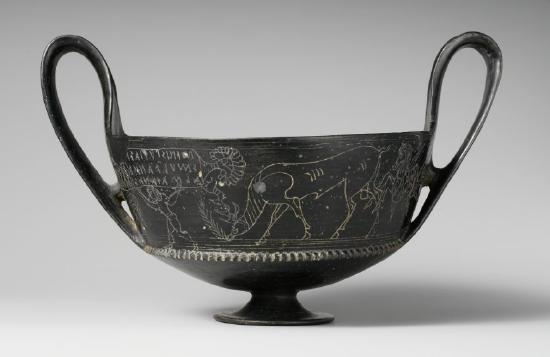
Bucchero, a distinctly black, burnished ceramic ware, is often considered the signature ceramic fabric of the Etruscans, an indigenous, pre-Roman people of the Italian peninsula. The term bucchero derives from the Spanish term búcaro (Portuguese: pucaro), meaning either a ceramic jar or a type of aromatic clay. The main period of bucchero production and use stretches from the seventh to the fifth centuries B.C.E. A tableware made mostly for elite consumption, bucchero pottery occupies a key position in our understanding of Etruscan material culture.
Manufacture
Bucchero’s distinctive black color results from its manufacturing process. The pottery is fired in a reducing atmosphere, meaning the amount of oxygen in the kiln’s firing chamber is restricted, resulting in the dark color. The oxygen-starved atmosphere of the kiln causes the iron oxide in the clay to give up its oxygen molecules, making the pottery darken in color. The fact that pottery was burnished (polished by rubbing) before firing creates the high, almost metallic, sheen. This lustrous, black finish is a hallmark of bucchero pottery. Another hallmark is the fine surface of the pottery, which results from the finely levigated (ground) clay used to make bucchero.
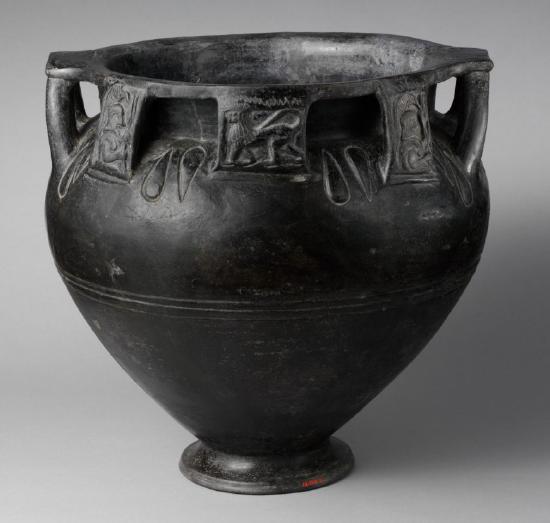
Bucchero wares may draw their inspiration from metalware vessels, particularly those crafted of silver, that would have been used as elite tablewares. The design of early bucchero ware seems to evoke the lines and crispness of metallic vessels; additionally early decorative patterns that rely on incision and rouletting (roller-stamping) also evoke metalliform design tendencies.
Forerunners of Etruscan bucchero
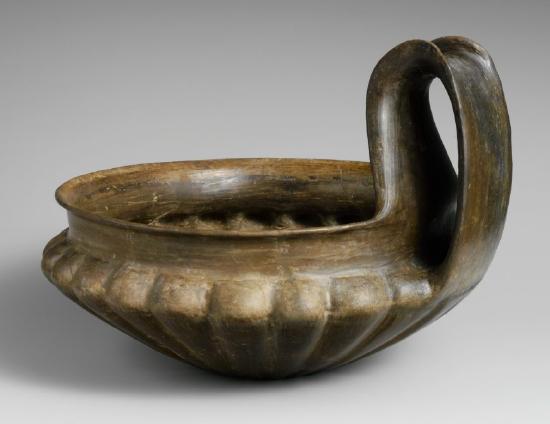
Impasto (a rough unrefined clay) ceramics produced by the Villanovan culture (the earliest Iron Age culture of central and northern Italy) were forerunners of Etruscan bucchero forms. Also called buccheroid impasto, they were the product of a kiln environment that allows for a preliminary phase of oxidation but then only a partial reduction, yielding a surface finish that ranges from dark brown to black, but with a section that remains fairly light in color. The kyathos in the Metropolitan Museum of Art (above) provides a good example; the quality of potting is high overall. This impasto ware was thrown on the wheel, has a highly burnished surface, but has a less refined fabric (material) than later examples of true bucchero.
Bucchero types
Archaeologists have discovered bucchero in Etruria and Latium (modern Tuscany and northern Lazio) in central Italy; it is often frequently found in funereal contexts. Bucchero was also exported, in some cases, as examples have been found in southern France, the Aegean, North Africa, and Egypt.
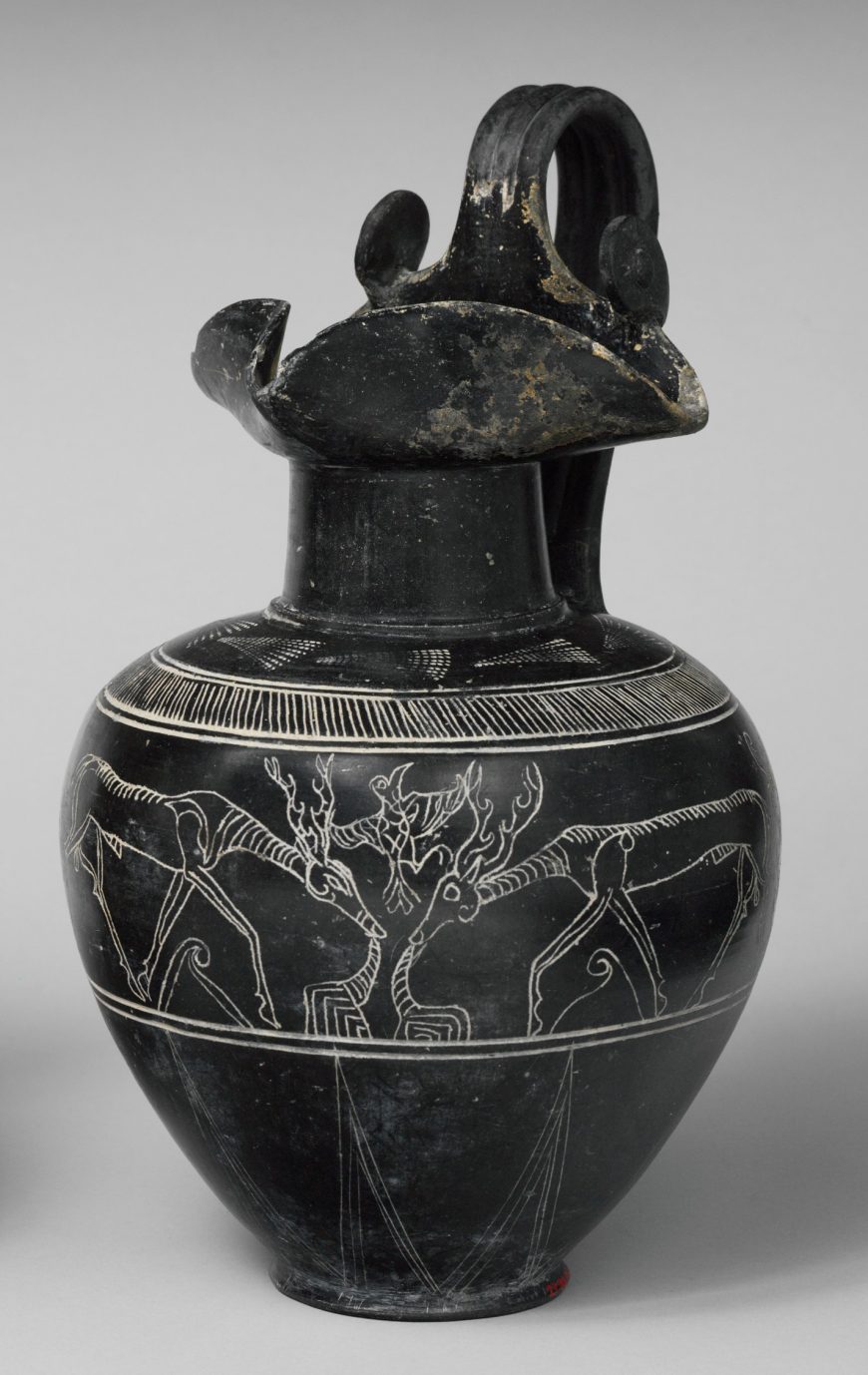
The production of bucchero is typically divided into three artistic phases. These are distinguishable on the basis of the quality and thickness of the fabric. The phases are: “thin-walled bucchero” (bucchero sottile), produced c. 675 to 626 B.C.E., “transitional,” produced c. 625 to 575 B.C.E., and “heavy bucchero” (bucchero pesante), produced from c. 575 to the beginning of the fifth century B.C.E.
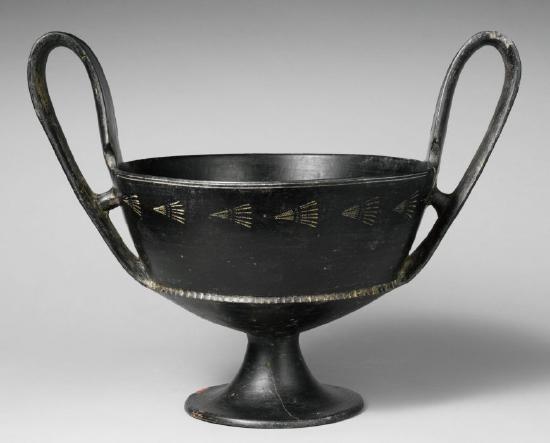
The earliest bucchero has been discovered in tombs at Caere (just northwest of Rome). Its extremely thin-walled construction and sharp features echo metallic prototypes. Decoration on the earliest examples is usually in the form of geometric incision, including chevrons and other linear motifs (above). Roller stamp methods would later replace the incision.
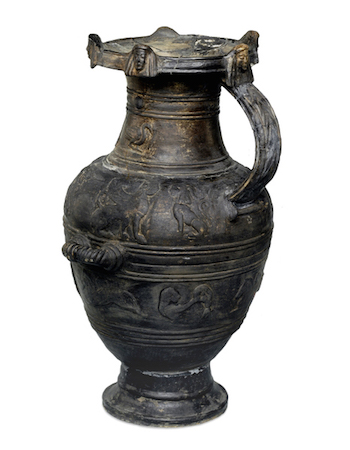
By the sixth century B.C.E., a “heavy” type of the ceramic had replaced the thin-walled bucchero. A hydria (vessel used to carry water) in the British Museum (above) is another example of the “heavy” bucchero of the sixth century B.C.E. This vessel has a series of female appliqué heads as well as other ornamentation. A tendency of the “heavy” type also included the use of mold-made techniques to create relief decoration.
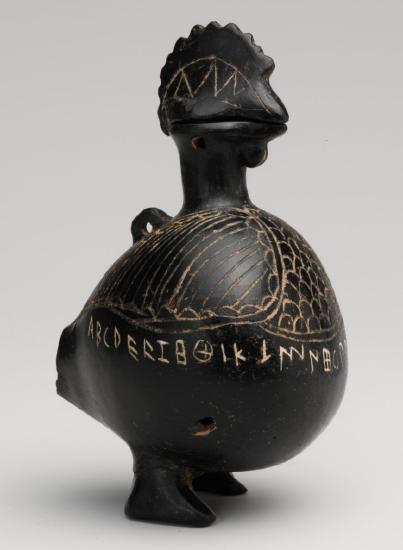
A number of surviving bucchero examples carry incised inscriptions. A bucchero vessel currently in the collection of the Metropolitan Museum of Art (above) provides an example of an abecedarium (the letters of the alphabet) inscribed on a ceramic vessel. This vase, in the form of a cockerel, dates to the second half of the seventh century B.C.E. has the 26 letters of the Etruscan alphabet inscribed around its belly (below)—the vase combines practicality (it may have been used as an inkwell) with a touch of whimsy. It demonstrates the penchant of Etruscan potters for incision and the plastic modeling of ceramic forms.

Interpretation
Bucchero pottery represents a key source of information about the Etruscan civilization. Used by elites at banquets, bucchero demonstrates the tendencies of elite consumption among the Etruscans. The elite display at the banqueting table helped to reinforce social rank and to allow elites to advertise the achievements and status of themselves and their families.
Additional Resources:
Bucchero at the British Museum
Jon M. Berkin, The Orientalizing Bucchero from the Lower Building at Poggio Civitate (Murlo) (Boston: Published for the Archaeological Institute of America by the University of Pennsylvania Museum of Archaeology and Anthropology, 2003).
Mauro Cristofani, Le tombe da Monte Michele nel Museo archeologico di Firenze (Florence: Leo S. Olschki, 1969).
Richard DePuma, Corpus vasorum antiquorum. [United States of America]. The J. Paul Getty Museum, Malibu: Etruscan Impasto and Bucchero (Corpus vasorum antiquorum., United States of America, fasc. 31: fascim. 6.) (Malibu: The J. Paul Getty Museum, 1996).
Richard DePuma, Etruscan Art in the Metropolitan Museum of Art (New York: Metropolitan Museum of Art, 2013).
Nancy Hirschland-Ramage, “Studies in Early Etruscan Bucchero,” Papers of the British School at Rome 38 (1970), pp. 1–61.
Philip Perkins, Etruscan Bucchero in the British Museum (London: The British Museum, 2007).
Tom Rasmussen, Bucchero Pottery from Southern Etruria (Cambridge: Cambridge University Press, 1979).
Wim Regter, Imitation and Creation: Development of Early Bucchero Design at Cerveteri in the Seventh Century B.C. (Amsterdam: Allard Pierson Museum, 2003).
Margaret Wadsworth, “A Potter’s Experience with the Method of Firing Bucchero,” Opuscula Romana 14 (1983), pp. 65-68.
Temple of Minerva and the sculpture of Apollo (Veii)
Forget what you know about Greek and Roman architectural orders—Etruscans had their own unique style.
Etruscan temples have largely vanished
Among the early Etruscans, the worship of the Gods and Goddesses did not take place in or around monumental temples as it did in early Greece or in the Ancient Near East, but rather, in nature. Early Etruscans created ritual spaces in groves and enclosures open to the sky with sacred boundaries carefully marked through ritual ceremony.
Figure \(\PageIndex{15}\): Reconstruction of an Etruscan Temple of the 6th century according to Vitruvius
Around 600 B.C.E., however, the desire to create monumental structures for the gods spread throughout Etruria, most likely as a result of Greek influence. While the desire to create temples for the gods may have been inspired by contact with Greek culture, Etruscan religious architecture was markedly different in material and design. These colorful and ornate structures typically had stone foundations but their wood, mud-brick and terracotta superstructures suffered far more from exposure to the elements. Greek temples still survive today in parts of Greece and southern Italy since they were constructed of stone and marble but Etruscan temples were built with mostly ephemeral materials and have largely vanished.
How do we know what they looked like?
Despite the comparatively short-lived nature of Etruscan religious structures, Etruscan temple design had a huge impact on Renaissance architecture and one can see echoes of Etruscan, or ‘Tuscan,’ columns (doric columns with bases) in many buildings of the Renaissance and later in Italy. But if the temples weren’t around during the 15th and 16th centuries, how did Renaissance builders know what they looked like and, for that matter, how do we know what they looked like?
Fortunately, an ancient Roman architect by the name of Vitruvius wrote about Etruscan temples in his book De architectura in the late first century B.C.E. In his treatise on ancient architecture, Vitruvius described the key elements of Etruscan temples and it was his description that inspired Renaissance architects to return to the roots of Tuscan design and allows archaeologists and art historians today to recreate the appearance of these buildings.
Archaeological evidence for the Temple of Minerva

The archaeological evidence that does remain from many Etruscan temples largely confirms Vitruvius’s description. One of the best explored and known of these is the Portonaccio Temple dedicated to the goddess Minerva (Roman=Minerva/Greek=Athena) at the city of Veii about 18 km north of Rome. The tufa-block foundations of the Portonaccio temple still remain and their nearly square footprint reflects Vitruvius’s description of a floor plan with proportions that are 5:6, just a bit deeper than wide.
The temple is also roughly divided into two parts—a deep front porch with widely-spaced Tuscan columns and a back portion divided into three separate rooms. Known as a triple cella, this three room configuration seems to reflect a divine triad associated with the temple, perhaps Menrva as well as Tinia (Jupiter/Zeus) and Uni (Juno/Hera).
In addition to their internal organization and materials, what also made Etruscan temples noticeably distinct from Greek ones was a high podium and frontal entrance. Approaching the Parthenon with its low rising stepped entrance and encircling forest of columns would have been a very different experience from approaching an Etruscan temple high off the ground with a single, defined entrance.
Sculpture
Perhaps most interesting about the Portonaccio temple is the abundant terracotta sculpture that still remains, the volume and quality of which is without parallel in Etruria. In addition to many terracotta architectural elements (masks, antefixes, decorative details), a series of over life-size terracotta sculptures have also been discovered in association with the temple. Originally placed on the ridge of temple roof, these figures seem to be Etruscan assimilations of Greek gods, set up as a tableau to enact some mythic event.
Apollo of Veii

The most famous and well-preserved of these is the Aplu (Apollo of Veii), a dynamic, striding masterpiece of large scale terracotta sculpture and likely a central figure in the rooftop narrative. His counterpart may have been the less well-preserved figure of Hercle (Hercules) with whom he struggled in an epic contest over the Golden Hind, an enormous deer sacred to Apollo’s twin sister Artemis. Other figures discovered with these suggest an audience watching the action. Whatever the myth may have been, it was a completely Etruscan innovation to use sculpture in this way, placed at the peak of the temple roof—creating what must have been an impressive tableau against the backdrop of the sky.

An artist by the name of Vulca?
Since Etruscan art is almost entirely anonymous it is impossible to know who may have contributed to such innovative display strategies. We may, however, know the name of the artist associated with the workshop that produced the terracotta sculpture. Centuries after these pieces were created, the Roman writer Pliny recorded that in the late 6th century B.C.E., an Etruscan artist by the name of Vulca was summoned from Veii to Rome to decorate the most important temple there, the temple of Jupiter Optimus Maximus. The technical knowledge required to produce terracotta sculpture at such a large scale was considerable and it may just have been the master sculptor Vulca whose skill at the Portonaccio temple earned him not only a prestigious commission in Rome but a place in the history books as well.
Additional Resources:
Etruscan art on The Metropolitan Museum of Art’s Heilbrunn Timeline of Art History
SmartHistory images for teaching and learning:
Figure \(\PageIndex{19}\): More SmartHistory images…
Apulu (Apollo of Veii)
by DR. STEVEN ZUCKER and DR. BETH HARRIS
Confronting Hercules in the middle of his labors, this clay statue of Apollo strides forward.
Sarcophagus of the Spouses (Louvre)

The freedom enjoyed by Etruscan women
One of the distinguishing features of Etruscan society, and one that caused much shock and horror to their Greek neighbors, was the relative freedom enjoyed by Etruscan women. Unlike women in ancient Greece or Rome, upper class Etruscan women actively participated in public life—attending banquets, riding in carriages and being spectators at (and participants in) public events. Reflections of such freedoms are found throughout Etruscan art; images of women engaged in these activities appear frequently in painting and in sculpture.
The Sarcophagus of the Spouses was found in Cerverteri, a town in Italy north of Rome, which is the site of a large Etruscan necropolis (or cemetery), with hundreds of tombs. The sarcophagus vividly evokes both the social visibility of Etruscan women and a type of marital intimacy rarely seen in Greek art from this period.
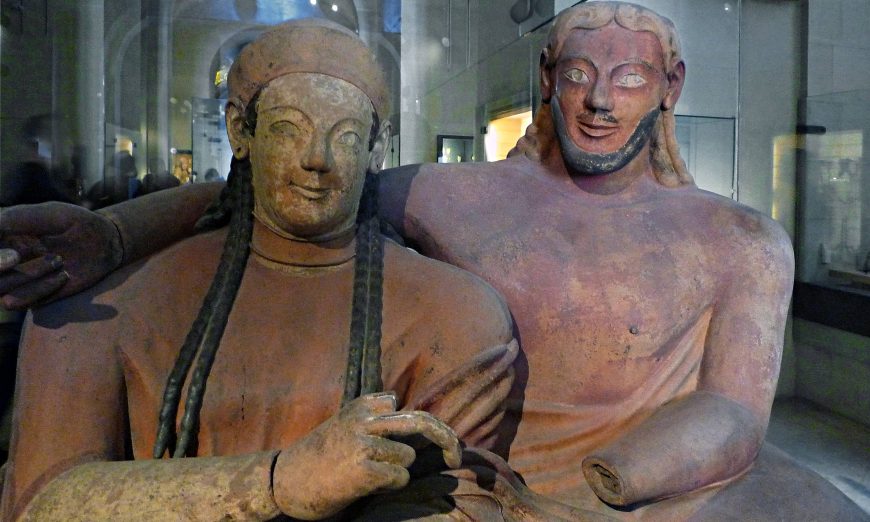
A funerary banquet?
In the sarcophagus (and another largely identical example at the Villa Giulia in Rome), the two figures recline as equals as they participate in a banquet, possibly a funerary banquet for the dead. In contemporary Greece, the only women attending public banquets, or symposia, were courtesans, not wives! The affectionate gestures and tenderness between the Etruscan man and woman convey a strikingly different attitude about the status of women and their relative equality with their husbands.
Terracotta
Aside from its subject matter, the sarcophagus is also a remarkable example of Etruscan large-scale terracotta sculpture (terracotta is a type of ceramic also called earthenware). At nearly two meters long, the object demonstrates the rather accomplished feat of modeling clay figures at nearly life-size. Artists in the Etruscan cities of Cerveteri and Veii in particular preferred working with highly refined clay for large-scale sculpture as it provided a smooth surface for the application of paint and the inclusion of fine detail.
Handling such large forms, however, was not without complications; evidence of this can be seen in the cut that bisects the sarcophagus. Splitting the piece in two parts would have allowed the artist to more easily manipulate the pieces before and after firing. If you look closely, you can also see a distinct line separating the figures and the lid of the sarcophagus; this was another trick for creating these monumental pieces—modeling the figures separately and then placing them on top of their bed.
Color
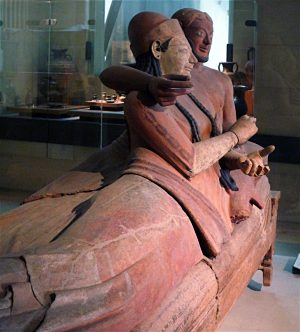
A really lovely characteristic of this sculpture is the preservation of so much color. In addition to colored garments and pillows, red laced boots, her black tresses and his blond ones, one can easily discern the gender specific skin tones so typical in Etruscan art. The man’s ochre flesh signifies his participation in a sun-drenched, external world, while the woman’s pale cream skin points to a more interior, domestic one. Gendered color conventions were not exclusive to the Etruscans but have a long pedigree in ancient art. Though their skin and hair color may be different, both figures share similar facial features—archaic smiles (like the ones we see in ancient Greek archaic sculptures), almond shaped eyes, and highly arched eyebrows—all typical of Etruscan art.
What were they holding?
One of the great puzzles of the sarcophagus centers on what the figures were holding. Etruscan art often featured outsized, expressive hands with suggestively curled fingers. Here the arm positions of both figures hint that each must have held small objects, but what? Since the figures are reclining on a banqueting couch, the objects could have been vessels associated with drinking, perhaps wine cups, or representations of food. Another possibility is that they may have held alabastra, small vessels containing oil used for anointing the dead. Or, perhaps, they held all of the above—food, drink and oil, each a necessity for making the journey from this life to the next.
Whatever missing elements, the conviviality of the moment and intimacy of the figures capture the life-affirming quality often seen in Etruscan art of this period, even in the face of death.
Additional resources:
Etruscan Necropolises of Cerveteri and Tarquinia (UNESCO)
Etruscan Art on The Metropolitan Museum of Art’s Heilrbunn Timeline of Art History
Conservation in Action: Etruscan Sarcophagi
SmartHistory images for teaching and learning:
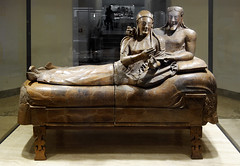
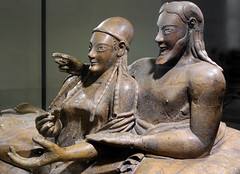
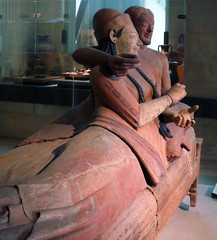
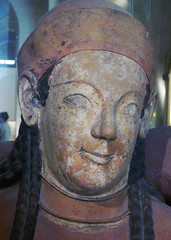
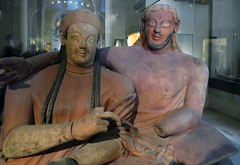
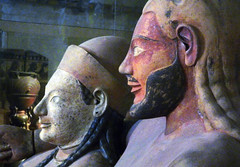
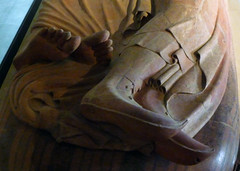
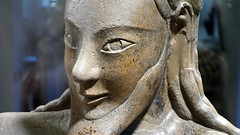
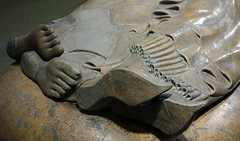
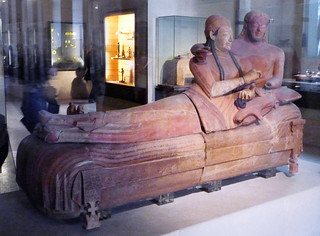
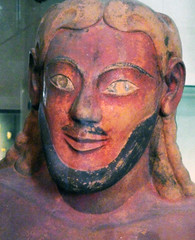

Sarcophagus of the Spouses (Rome)
The intimacy of this clay sculpture is unprecedented in the ancient world. What can it tell us about Etruscan culture?
Video \(\PageIndex{4}\): Sarcophagus of the Spouses (or Sarcophagus with Reclining Couple), from the Banditaccia necropolis, Cerveteri, Italy, c. 520 B.C.E., painted terracotta, 3′ 9 1/2″ x 6′ 7″ (Museo Nazionale Etrusco di Villa Giulia, Rome)
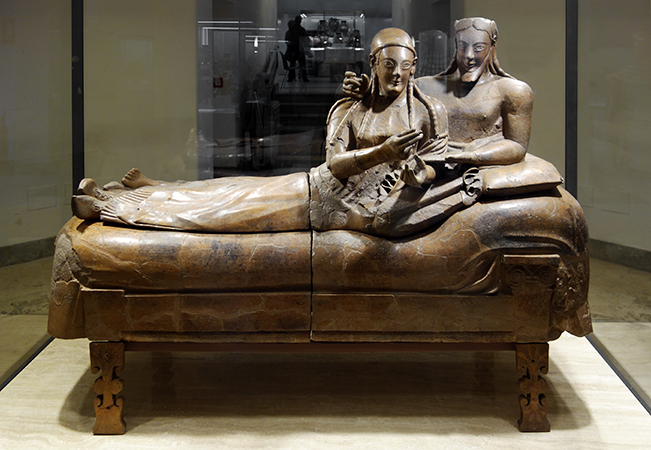
The Sarcophagus of the Spouses is an anthropoid (human-shaped), painted terracotta sarcophagus found in the ancient Etruscan city of Caere (now Cerveteri, Italy). The sarcophagus, which would have originally contained cremated human remains, was discovered during the course of archaeological excavations in the Banditaccia necropolis of ancient Caere during the nineteenth century and is now in Rome. The sarcophagus is quite similar to another terracotta sarcophagus from Caere depicting a man and woman that is presently housed in the Louvre Museum in Paris; these two sarcophagi are contemporary to one another and are perhaps the products of the same artistic workshop.
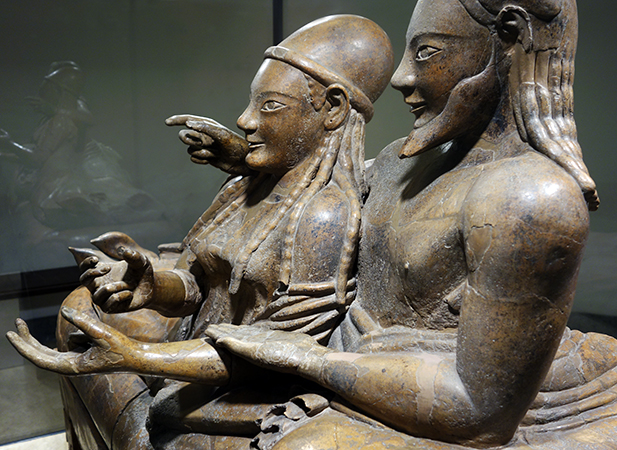
An archaic couple
The sarcophagus depicts a reclining man and woman on its lid. The pair rests on highly stylized cushions, just as they would have done at an actual banquet. The body of the sarcophagus is styled so as to resemble a kline (dining couch). Both figures have highly stylized hair, in each case plaited with the stylized braids hanging rather stiffly at the sides of the neck. In the female’s case the plaits are arranged so as to hang down in front of each shoulder. The female wears a soft cap atop her head; she also wears shoes with pointed toes that are characteristically Etruscan. The male’s braids hang neatly at the back, splayed across the upper back and shoulders. The male’s beard and the hair atop his head is quite abstracted without any interior detail. Both figures have elongated proportions that are at home in the archaic period in the Mediterranean.
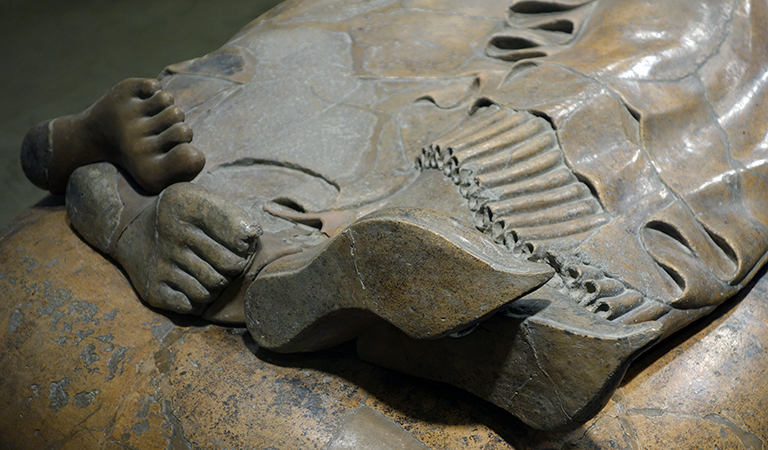
A banquet
The Sarcophagus of the Spouses has been interpreted as belonging to a banqueting scene, with the couple reclining together on a single dining couch while eating and drinking. This situates the inspiration for the sarcophagus squarely in the convivial (social) sphere and, as we are often reminded, conviviality was central to Etruscan mortuary rituals. Etruscan funerary art—including painted tombs—often depicts scenes of revelry, perhaps as a reminder of the funeral banquet that would send the deceased off to the afterlife or perhaps to reflect the notion of perpetual conviviality in said afterlife. Whatever the case, banquets provide a great deal of iconographic fodder for Etruscan artists.

In the case of the sarcophagus it is also important to note that at Etruscan banquets, men and women reclined and ate together, a circumstance that was quite different from other Mediterranean cultures, especially the Greeks. We see multiple instances of mixed gender banquets across a wide chronological range, leading us to conclude that this was common practice in Etruria. The terracotta plaque from Poggio Civitate, Murlo (above), for instance, that is roughly contemporary to the sarcophagus of the spouses shows a close iconographic parallel for this custom. This cultural custom generated some resentment—even animus—on the part of Greek and Latin authors in antiquity who saw this Etruscan practice not just as different, but took it as offensive behavior. Women enjoyed a different and more privileged status in Etruscan society than did their Greek and Roman counterparts.
Technical achievement
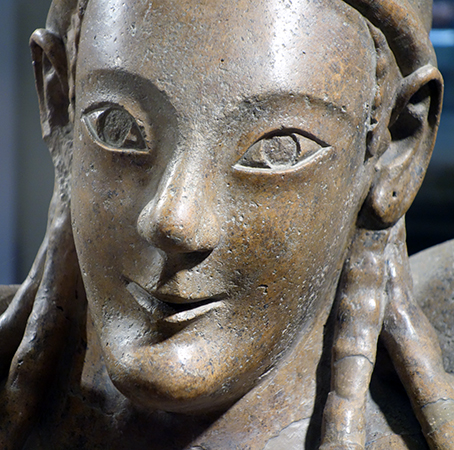
The Sarcophagus of the Spouses is a masterwork of terracotta sculpture. Painted terracotta sculpture played a key role in the visual culture of archaic Etruria. Terracotta artwork was the standard for decorating the superstructure of Etruscan temples and the coroplastic (terracotta) workshops producing these sculptures often displayed a high level of technical achievement. This is due, in part, to the fact that ready sources of marble were unknown in archaic Italy. Even though contemporary Greeks produced masterworks in marble during the sixth century B.C.E., terracotta statuary such as this sarcophagus itself counts as a masterwork and would have been an elite commission. Contemporary Greek colonists in Italy also produced high level terracotta statuary, as exemplified by the seated statue of Zeus from Poseidonia (later renamed Paestum) that dates c. 530 B.C.E.
Etruscan culture
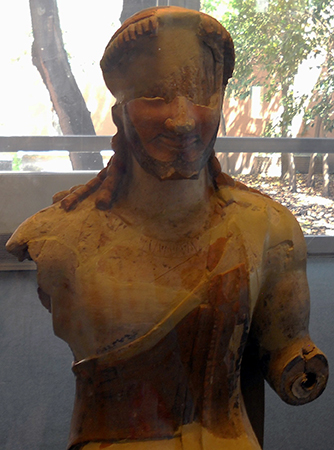
In the case of the Caeretan sarcophagus, it is an especially challenging commission. Given its size, it would have been fired in multiple pieces. The composition of the reclining figures shows awareness of Mediterranean stylistic norms in that their physiognomy reflects an Ionian influence (Ionia was a region in present-day Turkey, that was a Greek colony)—the rounded, serene faces and the treatment of hairstyles would have fit in with contemporary Greek styles. However, the posing of the figures, the angular joints of the limbs, and their extended fingers and toes reflect local practice in Etruria. In short, the artist and his workshop are aware of global trends while also catering to a local audience. While we cannot identify the original owner of the sarcophagus, it is clear that the person(s) commissioning it would have been a member of the Caeretan elite.
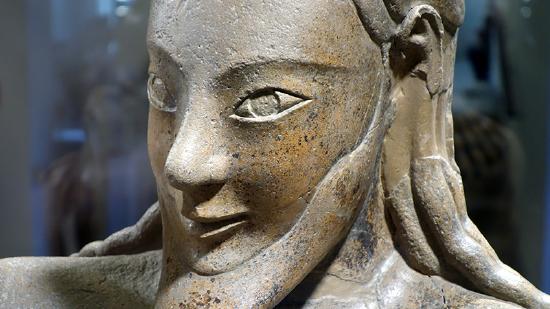
The Sarcophagus of the Spouses as an object conveys a great deal of information about Etruscan culture and its customs. The convivial theme of the sarcophagus reflects the funeral customs of Etruscan society and the elite nature of the object itself provides important information about the ways in which funerary custom could reinforce the identity and standing of aristocrats among the community of the living.
Additional resources:
L. Bonfante, ed., Etruscan Life and Afterlife: a Handbook of Etruscan Studies (Detroit: Wayne State University Press, 1986).
M. F. Briguet, Le sarcophage des époux de Cerveteri du Musée du Louvre. (Florence: Leo Olschki, 1989).
O. J. Brendel, Etruscan Art, 2nd ed. (New Haven: Yale University Press, 1995).
S. Haynes, Etruscan Civilization: A Cultural History (Los Angeles, California: Getty Publications, 2000).
E. Macnamara, Everyday life of the Etruscans (London: Batsford, 1973).
E. Macnamara, The Etruscans (Cambridge, Mass.: Harvard University Press, 1991).
A. S. Tuck, “The Etruscan Seated Banquet: Villanovan Ritual and Etruscan Iconography,” American Journal of Archaeology 98.4 (1994): 617-628.
J. M. Turfa, ed., The Etruscan World (London: Routledge, 2013).
A. Zaccaria Ruggiu, More regio vivere: il banchetto aristocratico e la casa romana di età arcaica (Rome: Edizioni Quasar, 2003).
Tomb of the Triclinium
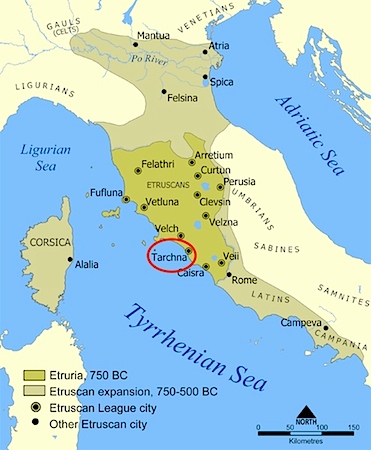
Elaborate funerary rituals
Funerary contexts constitute the most abundant archaeological evidence for the Etruscan civilization. The elite members of Etruscan society participated in elaborate funerary rituals that varied and changed according to both geography and time.
The city of Tarquinia (known in antiquity as Tarquinii or Tarch(u)na), one of the most powerful and prominent Etruscan centers, is known for its painted chamber tombs. The Tomb of the Triclinium belongs to this group and its wall paintings reveal important information about not only Etruscan funeral culture but also about the society of the living.
An advanced Iron Age culture, the Etruscans amassed wealth based on Italy’s natural resources (particularly metal and mineral ores) that they exchanged through medium- and long-range trade networks.
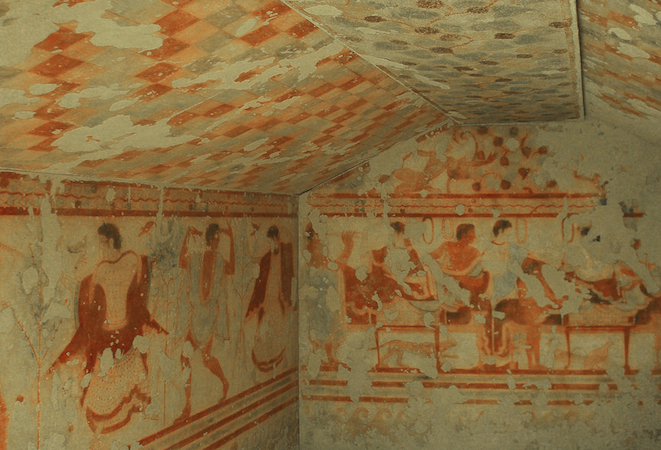
Tomb of the Triclinium
The Tomb of the Triclinium (Italian: Tomba del Triclinio) is the name given to an Etruscan chamber tomb dating c. 470 B.C.E. and located in the Monterozzi necropolis of Tarquinia, Italy. Chamber tombs are subterranean rock-cut chambers accessed by an approach way (dromos) in many cases. The tombs are intended to contain not only the remains of the deceased but also various grave goods or offerings deposited along with the deceased. The Tomb of the Triclinium is composed of a single chamber with wall decorations painted in fresco. Discovered in 1830, the tomb takes its name from the three-couch dining room of the ancient Greco-Roman Mediterranean, known as the triclinium.
A banquet
The rear wall of the tomb carries the main scene, one of banqueters enjoying a dinner party (above). It is possible to draw stylistic comparisons between this painted scene that includes figures reclining on dining couches (klinai) and the contemporary fifth century B.C.E. Attic pottery that the Etruscans imported from Greece. The original fresco is only partially preserved; although it is likely that there were originally three couches, each hosting a pair of reclining diners, one male and one female. Two attendants—one male, one female—attend to the needs of the diners. The diners are dressed in bright and sumptuous robes, befitting their presumed elite status. Beneath the couches we can observe a large cat, as well as a large rooster and another bird.
Music and dancing
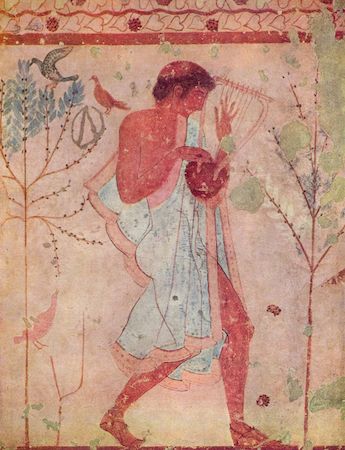
Scenes of dancers occupy the flanking left and right walls. The left wall scene contains four dancers—three female and one male—and a male musician playing the barbiton, an ancient stringed instrument similar to the lyre (left).
Common painterly conventions of gender typing are employed—the skin of females is light in color while male skin is tinted a darker tone of orange-brown. The dancers and musicians, together with the feasting, suggest the overall convivial tone of the Etruscan funeral. In keeping with ancient Mediterranean customs, funerals were often accompanied by games, as famously represented by the funeral games of the Trojan Anchises as described in book 5 of Vergil’s epic poem, the Aeneid. In the Tomb of the Triclinium we may have an allusion to games as the walls flanking the tomb’s entrance bear scenes of youths dismounting horses, variously described as being either apobates (participants in an equestrian combat sport) or the Dioscuri (mythological twins).
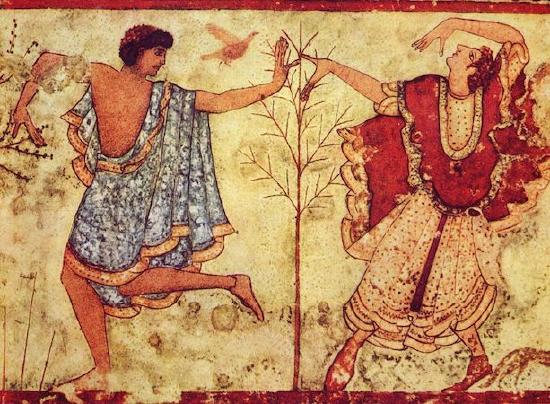
The tomb’s ceiling is painted in a checkered scheme of alternating colors, perhaps meant to evoke the temporary fabric tents that were erected near the tomb for the actual celebration of the funeral banquet.
The actual paintings were removed from the tomb in 1949 and are conserved in the Museo Nazionale in Tarquinia. As their state of preservation has deteriorated, watercolors made at the time of discovery have proven very important for the study of the tomb.
Interpretation
The convivial theme of the Tomb of the Triclinium might seem surprising in a funereal context, but it is important to note that the Etruscan funeral rites were not somber but festive, with the aim of sharing a final meal with the deceased as the latter transitioned to the afterlife. This ritual feasting served several purposes in social terms. At its most basic level the funeral banquet marked the transition of the deceased from the world of the living to that of the dead; the banquet that accompanied the burial marked this transition and ritually included the spirit of the deceased, as a portion of the meal, along with the appropriate dishes and utensils for eating and drinking, would then be deposited in the tomb. Another purpose of the funeral meal, games, and other activities was to reinforce the socio-economic position of the deceased person and his/her family: a way to remind the community of the living of the importance and standing of these people and thus tangibly reinforce their position in contemporary society. This would include, where appropriate, visual reminders of socio-political status, including indications of wealth and civic achievements, notably public offices held by the deceased.
Additional resources:
L. Bonfante, ed., Etruscan Life and Afterlife: a Handbook of Etruscan Studies (Detroit: Wayne State University Press, 1986).
O. J. Brendel, Etruscan Art, 2nd ed. (New Haven: Yale University Press, 1995).
P. Duell, “The tomba del Triclinio at Tarquinia.” Memoirs of the American Academy in Rome, volume 6, 1927, pp. 5-68.
S. Haynes, Etruscan Civilization: A Cultural History (Los Angeles, California: Getty Publications, 2000).
R. R. Holloway, “Conventions of Etruscan Painting in the Tomb of Hunting and Fishing at Tarquinii, “ American Journal of Archaeology, volume 69, number 4, 1965, pp. 341-7.
A. Naso, La pittura etrusca: guida breve (Rome: “L’Erma” di Bretschneider, 2005).
M. Pallottino, Etruscan Painting (Geneva: Skira, 1952).
S. Steingräber, Etruscan painting: catalogue raisonné of Etruscan wall paintings (New York: Johnson, 1985).
S. Steingräber, S., Abundance of Life: Etruscan Wall Painting (Los Angeles (California: Getty Publications, 2006).
J. M. Turfa, ed. The Etruscan World (London: Routledge, 2013).
A. Zaccaria Ruggiu, More regio vivere: il banchetto aristocratico e la casa romana di età arcaica (Rome: Edizioni Quasar, 2003)
The François Tomb
The François Tomb is chock-full of elaborate frescoes with complicated messages we may never fully understand.
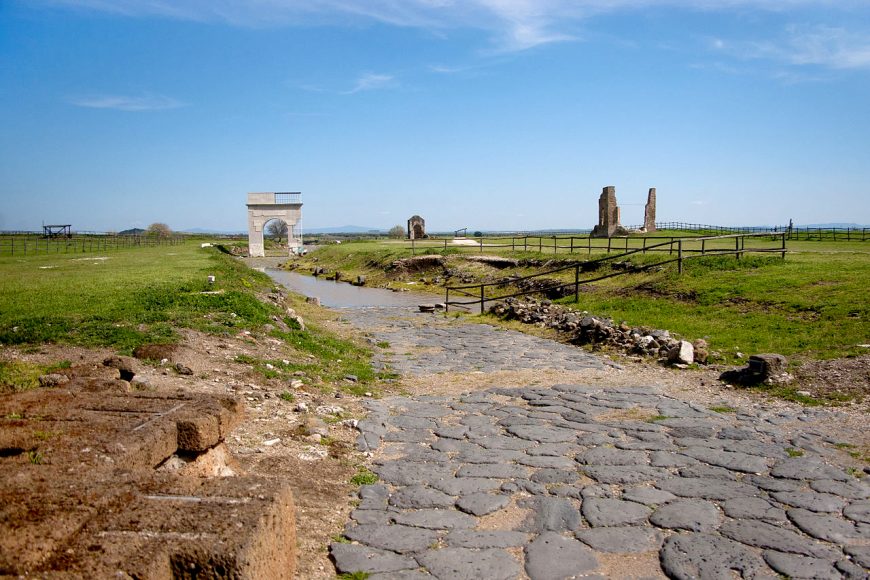
When Alessandro François and Adolphe Noël des Vergers entered the so-called François Tomb (named for its discoverer) in 1857, they described a magnificent treasure trove in which ancient Etruscan warriors were sleeping on their funeral couches, surrounded by grave goods, armaments, and brilliant tableaux on painted walls. This exceptional tomb from the Ponte Rotto necropolis in Vulci served as a familial burial monument and was used for several centuries in the Hellenistic period.
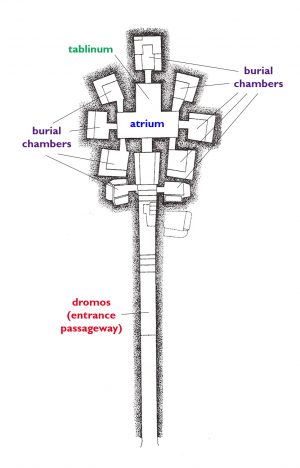
The Etruscans believed that the afterlife mirrored their own world, so they provided elaborate “homes” for their dead. The ground plan of the François Tomb is essentially a T shape, with two main chambers (called the atrium and tablinum after the rooms of typical Italo-Roman houses). The main chambers are arranged perpendicularly, with small burial chambers branching out from all sides.
The François Tomb is famous largely because of the frescoes of its main chamber, which can be dated to the fourth century B.C.E. Unlike most Etruscan tomb paintings, the François tomb frescoes seem to include battle scenes — making it a rare, early example of ancient history painting.
Though scholars still have many questions surrounding the exact meanings of these paintings, they reflect important Etruscan ideas about history, and they would have helped reinforce shared narratives about ancestry and the past as family members continually visited the tomb to inter the newly deceased.
Dazzling frescoes
Frescoes fill the walls and ceiling of the tomb. (The original frescoes were removed by a collector in the 19th century, and replaced in the tomb itself by reproductions.) The ceiling is designed to look like the interior of a building with a timber-framed roof structure, while the walls include various figural representations and geometric designs.

The atrium, which was the first room a visitor would enter, has the most elaborate frescoes. At the upper margin of the wall, there is a small running frieze in two registers: a Greek key pattern on top, with a hunting scene below. Under the hunting scene are larger scenes featuring human figures depicted at nearly life size.
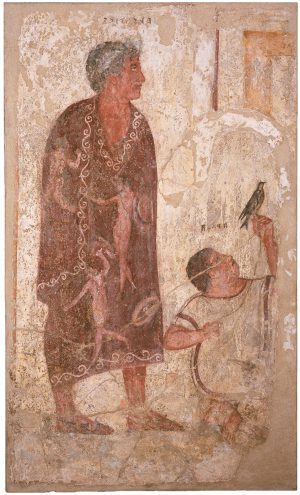
Although one wall was badly damaged, most of the figures are well-preserved and labeled with text. From this text we know that these figures include a mix of mythological characters (including Sisyphus, Eteocles and Polynices killing each other, and Ajax raping Cassandra) and historical figures, including the founder of the tomb, an Etruscan aristocrat named Vel Saties. This full-length portrait of Vel Saties wearing a toga picta has garnered acclaim as the first such portrait in western art.\(^{[1]}\) It is likely that the lowest quarter of the wall was obscured by stone benches, although not all of these benches have been preserved.
Scenes from mythology and history
The tablinum, or rear room of the tomb, also has benches at the bottom, a fresco representing a running meander at the top, and a scene featuring human figures in between. There are a few differences in the iconography that clearly separate the atrium and tablinum. First, the tablinum does not have a hunting scene below the meander; second, the ceiling patterns are different; and finally, the figural fresco is made up of two narrative scenes, each with labeled characters.
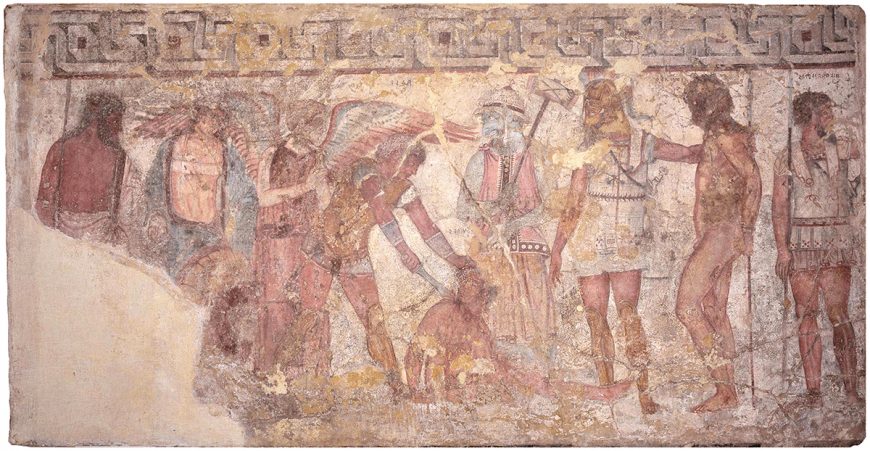
On the left-hand side of the tomb, there is a scene of Achilles sacrificing Trojan prisoners to the shade of Patroclus.
The right-hand side of the tomb shows a battle between two groups of Etruscans. It is this battle scene that has drawn the majority of historical attention. The figures are arranged into a series of dueling pairs on the long wall. Inscriptions identify the men on both sides as Etruscan, but only the figures who appear to be losing are identified with a specific city. This discrepancy has led scholars to believe that the winners are from Vulci. Because many of the dying men are only partially clothed, this scene has been interpreted as a nocturnal ambush: surprised in their sleep, the defeated figures were apparently not able to fully dress before the fighting started.
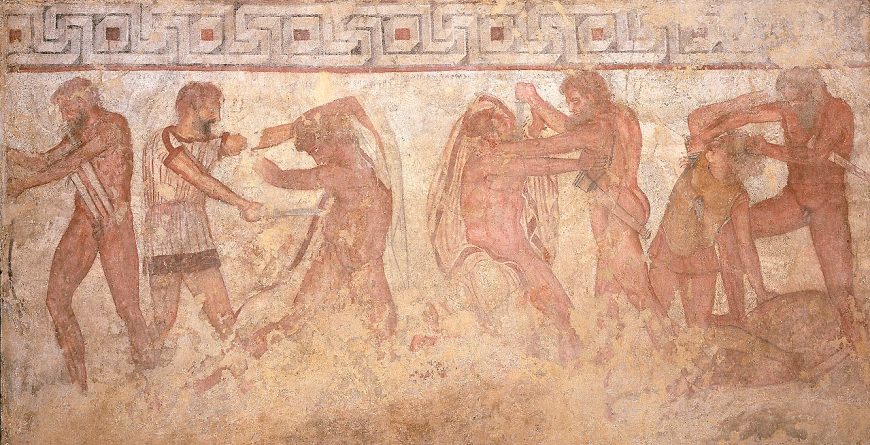
A link between text and image
Rounding the corner of the fresco is a scene derived from Rome’s legendary history. Mastarna (perhaps an alternate name for Servius Tullius, the legendary sixth king of Rome) frees Caelius Vibenna, an Etruscan aristocrat who aided Rome’s founder Romulus in his wars against Titus Tatius. Although these two men are portrayed nude (in the manner of mythological figures) there is some evidence that both were considered historical figures.
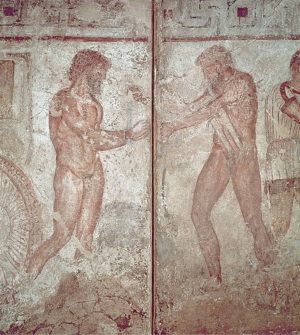
These paintings represent an important potential link between ancient visual and textual sources. The Roman emperor Claudius claimed in a speech that Mastarna was the Etruscan name of Rome’s sixth king, Servius Tullius, who was a friend of Caelius Vibenna (ILS 212). This is very similar to what is portrayed in the frescoes in the François tomb, and so the tomb’s iconography seems to provide independent confirmation of Claudius’ account.
Many scholars interpret the tomb’s iconography as being pro-Etruscan and anti-Roman. Since the Roman state made substantial territorial conquests in Etruria during the fourth century B.C.E., when the tomb was founded, the deployment of the iconography of Caelius Vibenna and Mastarna could have been a symbol of cultural pride among the Etruscans.
Unanswered questions
Despite widespread agreement about the fresco of Mastarna and Caelius Vibenna, questions remain about the meaning of many of the other frescoes in the François tomb.
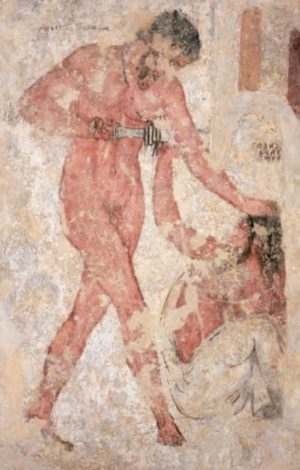
The atrium fresco depicts Camillus killing a figure identified as “Gaius Tarquinius of Rome.”
While both Camillus and Tarquinius are figures from early Roman history, their presence in the painting is not clearly understood. The name Tarquinius may refer to either of two male Tarquin rulers (or Tarquinii) from early Roman history; however, their first names were not Gaius, but Lucius, and neither of these men was killed by Camillus. Both Tarquinii lived around the time of Mastarna in the 6th century B.C.E., whereas Roman authors believed that Camillus lived about a century later, closer in time to the date of the tomb’s construction. To further complicate things, according to Roman tradition, Camillus was famous for defeating Etruscans. His presence in the tomb and his killing of Tarquinius are thus both mysterious.
Scholarly opinion is also divided on the relationship between the Camillus/Tarquinius fresco and the other historical fresco. Many scholars see them as part of the same narrative; others, however, argue that the two must be kept separate. This debate is unlikely to be resolved unless new evidence is discovered.
Mysteries remain
The François Tomb is rightly celebrated for its elaborate decor. Although we cannot fully understand the choices made by the tomb’s patron, it seems likely that the frescoes were created to deliver a specific message. This message may have been political (pro-Etruscan/anti-Roman), religious (since most scenes focus on bloodshed), familial (portraying the family history of the owners), or ethical (illustrating moral qualities that were important to the owners). All of these interpretations have been suggested, and it is possible that all of them are correct—that is, that the owner of the tomb had all of these aspects in mind when choosing the iconography. It is the historical fresco, however, that has captured the most interest, as it seems to preserve rare information about Etruscan historical thought.
We may never know the answers to many of these questions, but the François Tomb remains a shining example of Etruscan fresco painting that offers us a glimpse into the tumultuous history of the ancient Mediterranean world.
\(^{[1]}\)See Lisa C. Pieraccini, “Etruscan Wall Painting: Insights, Innovations, and Legacy” in Sinclair Bell and Alexandra A. Carpino, A Companion to the Etruscans (John Wiley & Sons, 2016), p. 256.
Additional resources:
The François Tomb at the Southern Etrurian Archaeological Heritage website (in Italian)
Vulci Park website with image gallery
B. Andreae, “Die Tomba François. Anspruch und historische Wirklichkeit eines etruskischen Familiengrabes.” In B. Andreae, A. Hoffman, C. Weder-Lehman (eds.), Die Etrusker: Luxus für das Jenseits. (Munich: Hirmer, 2004), pp. 176-207.
L. Bonfante Warren,“Roman Triumphs and Etruscan Kings.” The Journal of Roman Studies 60 (1970), pp. 49-66.
F. Buranelli and S. Buranelli, La Tomba François di Vulci. (Rome: Quasar, 1987).
F. Coarelli, F. “Le pitture della tomba François a Vulci : una proposta di lettura.” Dialoghi di Archeologia 3 (1983), pp. 43-69.
T. J. Cornell, The Beginnings of Rome (London: Routledge, 1995), pp. 135-141.
M. Cristofani, “Ricerche sulle pitture della tomba François di Vulci. I fregi decorativi,” Dialoghi di Archeologia 1 (1967), pp. 189-219.
N. T. de Grummond, Etruscan Myth, Sacred History, and Legend. (Philadelphia: University of Pennsylvania Museum, 2006), pp. 175-180, 197-199.
Jean Gagé, “De Tarquinies à Vulci : Les guerres entre Rome et Tarquinies au IVe siècle avant J.-C. et les fresques de la « Tombe François »” Mélanges d’archéologie et d’histoire publié par l’Ecole française de Rome 74 (1962), pp. 79-122.
Peter J. Holliday, “Narrative structures in the François tomb,” in Narrative and event in ancient art, (Cambridge, 1988), pp. 175-197.
A. Hus. Vulci Étrusque et Étrusco-Romaine. (Paris: Klincksieck, 1972).
Jaclyn Neel, Early Rome: Myth and Society (Wiley, 2017).
Jaclyn Neel, “The Vibennae: Etruscan Heroes and Roman Historiography” Etruscan Studies 20.1:1-34.
A. Sgubini Moretti (ed), Eroi Etruschi e Miti Greci. (Rome: Soprintendenza per i beni archeologici dell’Etruria meridionale, 2004).
Tomb of the Reliefs
All signs point to a party: cushions, drinking equipment, and armor hung on the wall … but a party in a tomb?

The banquet is over, the dining equipment is stowed, and the warriors sleep on in this Etruscan dining room, yet the evocative signs of a lively scene draw the viewer into the ancient world. These evocations of an Etruscan banquet—from the cushions to the drinking equipment to the armor hung on pegs on the walls—are situated firmly in the funereal sphere, one that is replete with reminders not only of life but also of death. In tomb interiors we find some of our most important and compelling evidence for an understanding of the first millennium B.C.E. world of the Etruscans.
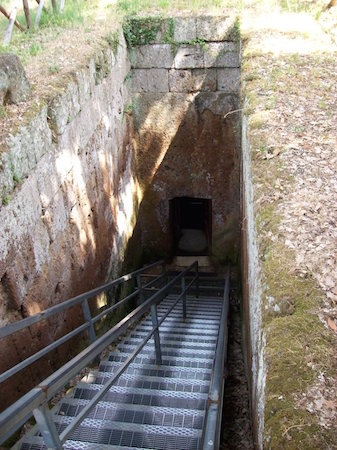
The Tomb of the Reliefs (Italian: Tomba dei Rilievi) is a late fourth or early third century B.C.E. rock-cut tomb (hypogeum) located in the Banditaccia necropolis of the ancient Etruscan city-state of Caere (now Cerveteri) in Italy (a necropolis is a large, ancient cemetery). The tomb takes its name from a series of painted stucco reliefs that cover the walls and piers of the tomb chamber itself. Unlike some of its neighbors that are covered mounds of earth (tumulus-type tombs), the Tomb of the Reliefs is of the rock-cut type and was excavated at a considerable depth in the bedrock, approached by a steep dromos (entranceway). This elite tomb once accommodated several dozen burials and is located, likely not by accident, close to an important tumulus-type tomb from the earlier Orientalizing period.
Inside the tomb
The plan of the tomb is roughly quadrangular. The entire tomb and all of its features have been carved from the bedrock (a type of volcanic mudstone known as tufa). The central block of the room, supported by two piers, is flanked by a series of niches for burials that have been styled to resemble the dining couches (klinai) of the ancient world. Decorative pilasters with volute (scroll-shaped) capitals separate the niches one from the other (see image below).
The tomb’s bas relief (low relief) decoration consists of carved bedrock features that have been stuccoed and painted. The decorative schema evokes the interior of an aristocratic house that is prepared to host a banquet or drinking party. The provisions for banqueters include cups and strainers hanging from pegs. The soldiers’ armor—shields, helmets, greaves (protective armor for the lower leg)—has been stowed by hanging it from pegs. The pilasters are also decorated, with the items depicted including a range of tools and implements as well as the depiction of a small carnivore, perhaps a weasel.
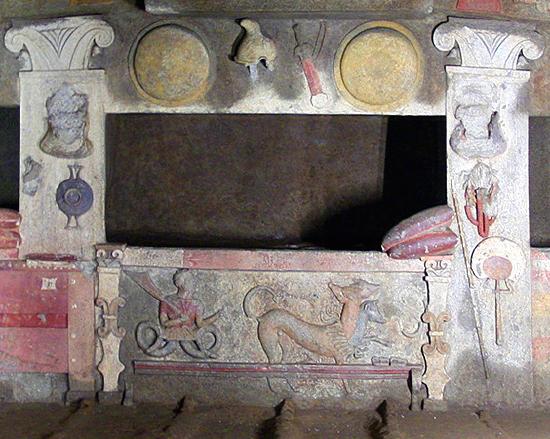
Beneath the central niche of the rear wall we find an allusion to the afterlife. There, under the side table we find, in relief, the hellhound Cerberus and an anguiped (serpents for legs) demon—perhaps the Etruscan god Charun who conducted the souls of the departed to the afterlife? This central niche, equipped with footstool, may have been intended for the male and female heads of the family.
The Matunas family is identified as the owner by way of an inscribed cippus (a small pillar). The inscription reads “Vel Metunas, (son) of Laris, who this tomb built.” A locked strongbox included in the relief may be meant to represent the container for storing the records of the family’s deeds (res gestae).
Video \(\PageIndex{5}\): More information about this video and a related panoramic tour can be found here.
Interpretation
The Tomb of the Reliefs is unusual in the corpus of Etruscan tombs, both for its richness and for its decorative scheme. The Matunas family, among the elite of Caere, make a fairly strong statement, by means of funerary display, about their familial status and accomplishments, even at a time when the cultural autonomy of the Etruscans—and of Caere itself—had already begun to wane. The funeral banquet remains an important and vibrant theme for Etruscan funerary art throughout the course of the Etruscan civilization. This convivial and festive rendering demonstrates to us that the funeral banquet not only sent the deceased off to the afterlife but also reinforced ties and status reminders among the community of the living.
Etruscan tombs at Cerveteri:
Additional resources:
Tomb of the Reliefs (from Archaeological Heritage in Southern Etruria)
Etruscan Tombs from the Toledo Museum of Art
H. Blanck and G. Proietti, La Tomba dei Rilievi di Cerveteri (Rome: De Luca, 1986).
O. J. Brendel, Etruscan Art. 2nd ed. (New Haven: Yale University Press, 1995)
M. Cristofani, “Le iscrizioni della tomba dei Rilievi di Cerveteri,” Studi etruschi 2 (1966), vol. 34, 221-238.
M. Cristofani, “I leoni funerari della tomba dei rilievi di Cerveteri,” Archeologia classica 20 (1968) 321-323.
S. Haynes, Etruscan Civilization: a Cultural History (Los Angeles, California: Getty Publications, 2000).
F. Prayon, Frühetruskische Grab- und Hausarchitektur (Heidelberg : F.H. Kerle, 1975).
S. Steingräber, Abundance of Life: Etruscan Wall Painting (Los Angeles, California: Getty Publications, 2006).
J. M. Turfa, ed. The Etruscan World (London: Routledge, 2013).
Chimera of Arezzo
A vicious mythic beast, the Chimera is a terrifying mix of animals—that even attacks itself.
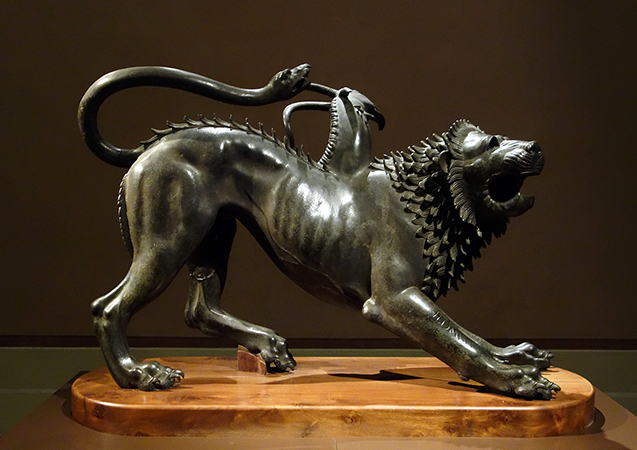
The Chimera of Arezzo is one of the best known pieces of Etruscan sculpture to survive from antiquity. Discovered near the Porta San Lorentino of Arezzo, Italy (ancient Arretium) in 1553, the statue was added to the collection of Cosimo I de’ Medici, Grand Duke of Tuscany in the sixteenth century and is currently housed in the Museo Archeologico Nazionale in Florence.
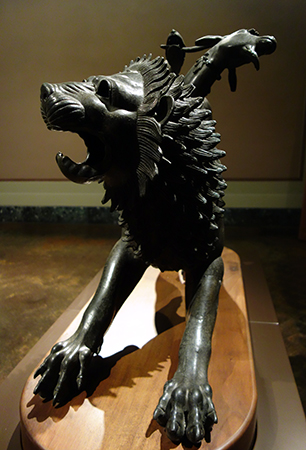
When the statue was discovered along with a collection of small bronzes, it was cleaned by Cosimo I and the artist Benvenuto Cellini; it was then displayed as part of the duke’s collection in the Palazzo Vecchio in Florence. Giorgio Vasari (16th century artist, writer, and historian), studied the statue and declared it a bona fide antiquity.
What is a chimera?
The Chimera was a legendary, fire-breathing monster of Greek myth that hailed from Lycia (southwestern Asia Minor). The offspring of Typhon and Echidna, the Chimera ravaged the lands of Lycia until Bellerophon, a hero from Corinth, mounted on the winged horse Pegasus was able to slay it (Hesiod Theogony 319-25). Typically the Chimera is a hybrid—often shown with elements from more than one animal incorporated into the whole; most often these include a lion’s head, with a goat rising from its back, and a snaky tail.
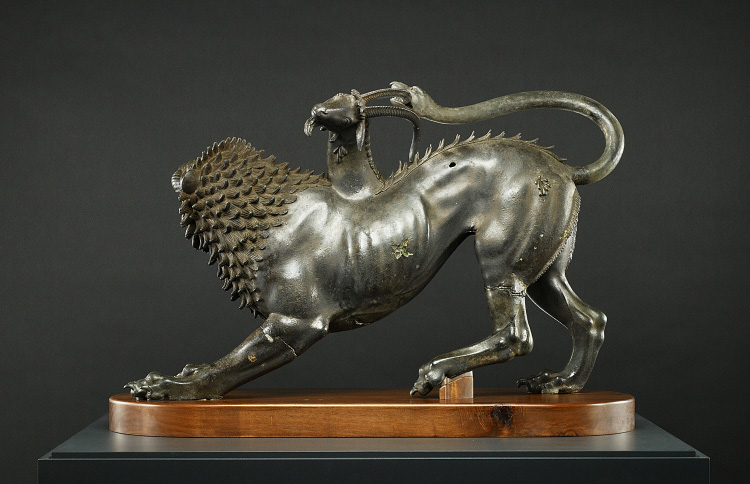
The Chimera of Arezzo presents a complex composition that seems conceived for viewing in the round. The contortions of the fire-breathing beast, obviously wounded in combat, evoke emotion and interest from the viewer. Its writhing body parts invite contemplation of the movement, pose, and musculature of the figure. While the tail was restored post-discovery, enough of the original composition confirms this dynamism. The lean body also emphasizes the tension in the arched back, the extended claws, and the roaring mouth set amidst the bristling mane.
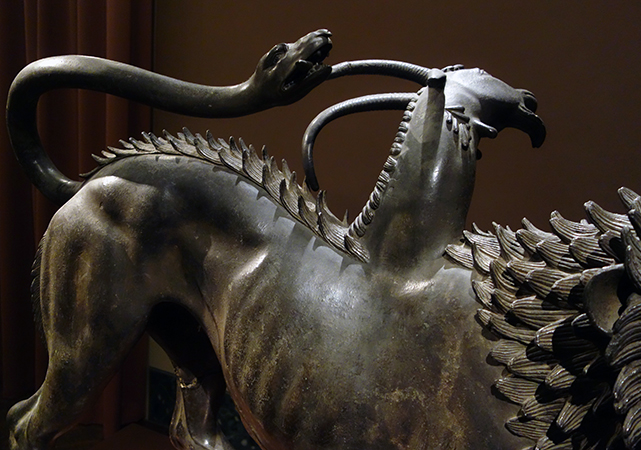
The right foreleg (below) bears a dedicatory inscription in the Etruscan language. The inscription reads, “tinścvil” meaning “Offering belonging to Tinia” (TLE 663; Bonfante and Bonfante 2002, no. 26 p. 147). This indicates that the statue was a votive object, offered as a gift to the sky god Tinia.

Interpretation
The Chimera of Arezzo is a masterwork of Etruscan bronze working, demonstrating not only a high level of technical proficiency on the part of the artist (or workshop) that produced it but also clearly showing a fine-tuned awareness of the themes of Greek mythology that circulated around the Mediterranean. A. Maggiani discusses the wider Italiote context in which the statue was likely produced—pointing out iconographic comparisons from sites in Magna Graecia such as Metaponto and Kaulonia (Italiote refers to pre-Roman Greek speaking peoples of southern Italy, while Magna Graecia refer to the Greek colonies established in Southern Italy from the 8th century B.C.E. onward).

These iconographic trends, indicative of increasing Attic (derived from the area around Athens, Greece) influence, suggests that the Chimera of Arrezo was produced by Italiote craftsmen who were influenced by the spread of Attic trends in art in the last years of the fifth century continuing through to the early fourth century B.C.E. The dedication of the statue as a votive offering to Tinia further reminds us of the wealth and sophistication of Etruscan elites who, in this case, could not only afford to commission the statue but could also afford to part with it in what may have been an ostentatious fashion.
Additional resources:
G. Bonfante & L. Bonfante, The Etruscan language: an introduction, revised edition (Manchester University Press, 2002).
L. Bonfante, “Etruscan Inscriptions and Etruscan Religion.” In The Religion of the Etruscans, edited by N.T. De Grummond and E. Simon, pp. 9–26 (Austin: University of Texas Press, 2006).
W. L. Brown, The Etruscan Lion (Oxford: Clarendon Press, 1960).
M. Cristofani, “Per una storia del collezionismo archeologico nella Toscana granducale. I. I grandi bronzi,” Prospettiva, 1979, vol. 17, pp. 4–15 .
M. Cristofani, I bronzi degli Etruschi (Novara: Istituto Geografico De Agostini, 1985).
M. Cristofani, “Chimereide,” Prospettiva vol. 61 (1991), pp. 2-5.
A. M. Gáldy, “The Chimera from Arezzo and Renaissance Etruscology,” in Common Ground: Archaeology, Art, Science, and Humanities. Proceedings of the XVIth International Congress of Classical Archaeology, Boston, August 23–26, 2003, edited by C.C. Mattusch, A.A. Donahue, and A. Brauer, pp. 111–13. (Oxford: Oxbow, 2006).
A. M. Gáldy, Cosimo I de’Medici as Collector: Antiquities and Archaeology in Sixteenth-Century Florence (Cambridge: Cambridge Scholars Publishing, 2009).
M. Iozzo et al., The Chimaera of Arezzo (Florence: Edizioni Polistampa, 2009).
M. Pallottino, “Vasari e la Chimera,” Prospettiva, vol. 8 (1977), pp. 4–6.
R. Pecchioli, “Indagini radiografiche,” in La Chimera d’Arezzo, edited by F. Nicosia and M. Diana, pp. 89–93 (Florence: Il Torchio, 1992).
C. M. Stibbe, “Bellerophon and the Chimaira on a Lakonian Cup by the Boreads Painter,” in Greek Vases in the J. Paul Getty Museum, vol. 5, edited by M. True, pp. 5–12 (Occasional Papers on Antiquities, vol. 7) (Malibu: The J. Paul Getty Museum, 1991).
J. M. Turfa, “Votive Offerings in Etruscan Religion,” In The Religion of the Etruscans, edited by N.T. De Grummond and E. Simon, pp. 90–115 (Austin: University of Texas Press, 2006).
Beth Cohen, “Chimera of Arezzo,” The American Journal of Archaeology, July 2010 (114.3).
“Chimera in Bronzo,” from the Ministero per i beni Culturali e Ambientali Soprintendenza Archeologica della Toscana Sezione Didattica (in Italian)
SmartHistory images for teaching and learning:
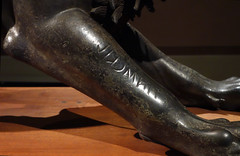
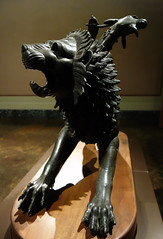




Mars of Todi
Lightning struck this statue dedicated to the Etruscan god of war, marking it as a particularly sacred object.

The religious sanctuaries of ancient Italy were busy and multi-faceted places, playing roles not only in religion and ritual, but also in commerce and connectivity. People visited sanctuaries to participate in ritual, connect with their community, and to commune with the gods. The religions of ancient Italy relied heavily on votive practices—that is the giving of gifts or offerings to the divinities that helped to affirm a pact or agreement between the worshipper and a god or goddess. Votives could be humble objects from everyday life, or they could be purpose-made prestige objects. In all cases, votives are particularly instructive in informing us about ritual practice in the ancient world.
The statue
The so-called Mars of Todi is an inscribed Etruscan bronze statue dating to the late fifth or early fourth century B.C.E. It was discovered in 1835 on the slopes of Mount Santo near Todi, Italy (ancient Tuder). The hollow-cast bronze statue is the product of an Etruscan workshop but was likely produced for the market in Umbria (a region in central Italy).
The statue measures 141 cm in height, making it nearly life-sized. The Etruscans were adept metalworkers and Orvieto (Etruscan Velzna, Roman Volsinii) was particularly known for the production of bronze statues. The Romans reportedly removed 2,000 bronzes from Volsinii when they captured it in 265 B.C.E. (Pliny, Natural History 34.33). It is possible that the Mars of Todi was originally produced there.
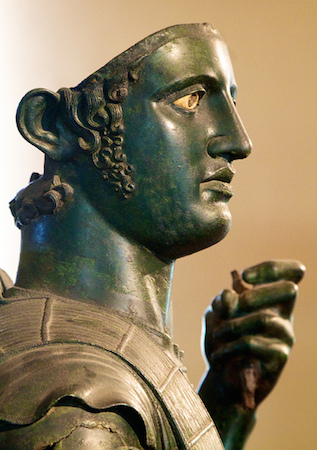
The warrior is clearly a prestige object, a worthy votive dedication. It is likely that the object was dedicated to Laran, the Etruscan god of war. Dressed in intricately worked plate armor, the figure takes a contrapposto stance and indicates that the Etruscan artist was aware of the formal elements of the Classical style of sculpture. These classicizing elements indicates that the artists of Etruria are not only aware of Mediterranean stylistic conventions but also that they are comfortable enough with these stylistic trends that they can in turn adapt and apply them to local tastes and demand. Likely attached elements—including a patera (a libation bowl) held in the right hand and a spear in the left—have not survived, nor has the helmet that he wore atop his head.
The inscription

The bronze statue bears an inscription in the Umbrian language that has been written using Etruscan characters. This dedication is inscribed on the skirt that is attached to the breastplate and reads “Ahal Trutitis dunum dede” (“Ahal Trutitis gave [this as a] gift”). The dedicant—Ahal Trutitis—has a name that is Celtic in origin, which lends this dedication of an Etruscan object in an Umbrian sanctuary a particularly cosmopolitan element.
Interpretation
The Mars of Todi is a rare object in that many prestige votives of its stature have not survived from antiquity. The careful burial of this object—perhaps after it had been struck by lightning*—accounts for its survival. The composition represents the tradition of libations made by soldiers prior to battle, an opportunity for beseeching the gods for support and success in battle. The dedication of this object is also indicative of the dynamic human landscape of ancient Italy—within that human landscape sanctuaries often served as nodal points where diverse cultures came into contact with one another. This votive statue, then, tells us a great deal not only about ritual practice and iconography, but also about those who frequented sanctuaries in ancient Italy.
*Note on lightning as sacred
In ancient Italic religion lightning was sacred, as it was connected to the chief sky god, called Iuppiter (Jupiter) by the Romans and Tinia by the Etruscans. Thus on occasions when lightning struck the Earth, the spot which—or the object which—the lightning “selected” (fulgur conditum) would become even more sacred. Roman ritual doctrine considered these consecrated spots special and thus they were often marked in some way. The Puteal Libonis (also known as Puteal Scribonianum) in the Comitium of the Forum Romanum provides such an example; after a spot in the Comitium had been struck by lightning, it was marked with a puteal (a marble wellhead) (Festus 333). The Romans considered these special shrines, which often had a circular templum (a sacred, inaugurated precinct), as bidentalia (from the Latin noun bidental, bidentalis “a place struck by lightning”) and it was forbidden to tread on them. In the case of the Mars of Todi, the statue was found carefully buried in a stone-lined cist, leading to the conclusion that the statue had been struck by lightning, which caused it to fall from its podium and that it was subsequently ritually buried. The ritual burial of votive objects is a common practice in ancient Mediterranean religions, but the treatment of these bidentalia was special in its own right.
Additional resources:
This sculpture in the Gregorio Etruscan Museum (Vatican Museums)
G. Bonfante and L. Bonfante, The Etruscan Language: An Introduction, revised edition (Manchester: Manchester University Press, 2002), p. 26.
G. J. Bradley, Ancient Umbria: State, Culture, and Identity in Central Italy from the Iron Age to the Augustan Era: State, Culture, and Identity in Central Italy from the Iron Age to the Augustan Era (Oxford: Oxford University Press, 2000). p. 92.
O. J. Brendel, Etruscan Art, 2nd ed. (New Haven: Yale University Press, 1995) p. 317.
D. Strong and J.M.C. Toynbee, Roman Art (New Haven: Yale University Press, 1976, 1988), pp. 32–33.
F. Roncalli, Il Marte di Todi: bronzistica etrusca ed ispirazione classica (Rome: Tip. poliglotta Vaticana, 1973).
E. Simon, “Gods in Harmony: The Etruscan Pantheon,” in The Religion of the Etruscans, ed. by N. T. De Grummond and E. Simon, pp. 45-65 (Austin: University of Texas Press, 2006).
J. M. Turfa, Divining the Etruscan World: the Brontoscopic Calendar and Religious Practice (Cambridge: Cambridge University Press, 2012).
SmartHistory images for teaching and learning:
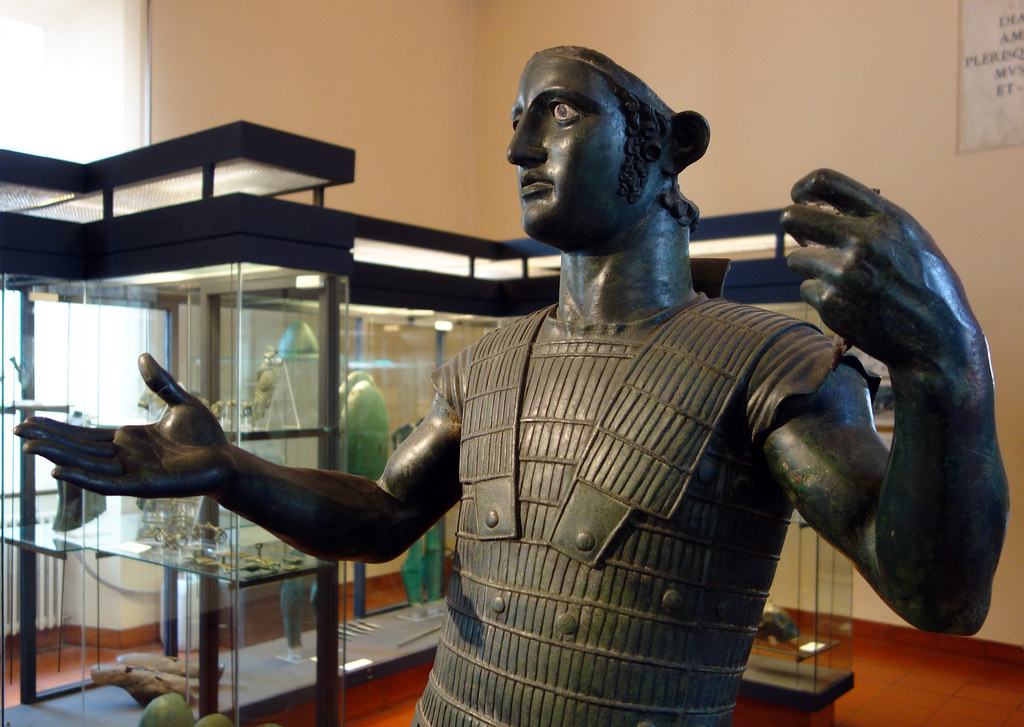
Aule Metele (Arringatore)
An Etruscan in Roman clothing, this figure is a masterwork—made as Etruscan culture was slipping away.
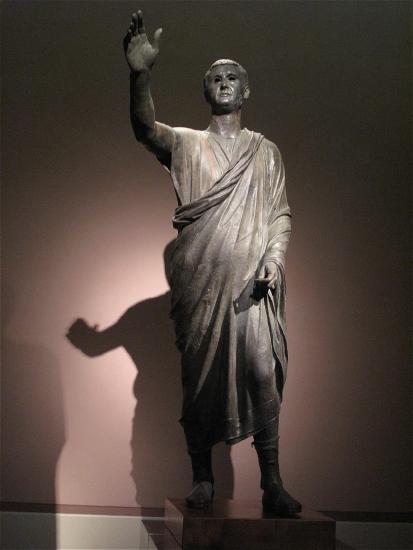
The image, status, and stature of the magistrate in the course of performing the duties of his office commands respect—and no pose is more riveting than that of the orator.
L’Arringatore (“The Orator”) is a hollow-cast bronze statue that was recovered from Lake Trasimeno in 1566. The statue is an important example of bronze sculpture in later first millennium B.C.E. Italy and indicates the gradual Romanization of Etruscan art.
The statue
The life-size statue depicts a draped adult male, standing with his right arm outstretched. The figure adopts a frontal pose with a slight contrapposto stance (contrapposto refers to the figure shifting his weight onto his right leg). Based on the inscription on the statue, the figure is identified as Aulus Metellus (or Aule Metele in Etruscan). He is clearly a magistrate and his posture seems to be that of the orator who is in the process of addressing the crowd. He wears a tunic over which is draped a toga—the formal attire of the magistrate. The toga is wrapped around the body, leaving the right arm free. On his feet are the high boots that were commonly worn by Roman senators. His expression and slightly opened mouth make him a compelling figure. The statue was originally erected by the community in honor of Aulus Metellus.
The inscription

The lower hem of the short toga carries an Etruscan inscription: “auleśi meteliś ve[luś] vesial clenśi / cen flereś tece sanśl tenine / tu θineś χisvlicś” which can be interpreted as reading, “To (or from) Auli Meteli, the son of Vel and Vesi, Tenine (?) set up this statue as a votive offering to Sans, by deliberation of the people” (TLE 651; CIE 4196).
Interpretation
The statue of Aulus Metellus offers us a glimpse of the changing socio-political landscape of the Italian peninsula during the latter first millennium B.C.E.—a period in which sweeping change brought on by the hegemonic fortunes of Rome and its booming population, signalled profound and lasting change for other Italic peoples, including the Etruscans. As Rome’s territory expanded during the fifth through first centuries B.C.E., her neighbors were gradually absorbed into the sphere of Roman cultural, economic, and political influence. Some groups, of course, resisted in one way or another, while others gladly “joined up” through political and military treaties and through adopting a Roman lifestyle. This process of acculturation–or Romanization, to use a term that is considered outmoded by some scholars—means that cultural heterogeneity becomes less visible in the archaeological record, replaced instead by a more homogeneous cultural model. These were the fortunes of the Etruscans—as the autonomy of the various Etruscan states eroded, the Etruscans themselves elected to adopt the trappings of a Roman culture that was, in turn, indicative of wider, pan-Mediterranean dynamics. Etruscan art, politics, and even language gradually slipped away.
Thus L’Arringatore is one of our latest surviving examples of a sculptural masterwork that still demonstrates the traits of an Etruscan workshop, all the while packaged for an increasingly Roman world. The statue clearly wears the short toga exigua (a kind of narrow toga) and senatorial boots that come from the Roman sphere. He is posed as an orator—highlighting his political career as both Etruscan and Roman aristocrats did. His haircut is in keeping with those of Roman aristocrats and his face may betray some evidence of the verism (truthfulness) popular among Roman elites of the late Republic. The statue still carries an inscription in Etruscan, though, and the working of the bronze is in keeping with the tendencies of Etruscan craftsmanship. Surely the historical Aulus Metellus witnessed a world that was changing rapidly and this statue that carries his inscribed name still bears silent witness to the patterns and dynamics of socio-cultural change in the Roman Mediterranean.
Additional resources:
L. Bonfante, Etruscan Dress (Baltimore: Johns Hopkins University Press, 1975).
G. Bonfante and L. Bonfante, The Etruscan Language: An Introduction, revised Edition (Manchester: Manchester University Press, 2002). p. 183 no. 66.
O. J. Brendel, Etruscan Art, 2nd ed. (New Haven: Yale University Press, 1995).
A. Corbeill, “The Republican Body,” in A Companion to the Roman Republic, edited by N. Rosenstein and R. Morstein-Marx, 439-456. (Malden MA: Blackwell, 2006).
T. Dohrn, Der Arringatore: Bronzestatue im Museo archeologico von Florenz (Berlin: Gebr. Mann, 1968).
S. Haynes, Etruscan Civilization: a Cultural History (Los Angeles, California: Getty Publications, 2000).
J. M. Turfa, ed., The Etruscan World (London: Routledge, 2013).
Etruscan Necropolises of Cerveteri and Tarquinia (from UNESCO/NHK)
by UNESCO and NIPPON HOSO KYOKAI
Doors to the afterlife, Etruscan tombs were happily decorated. But as war increased, that began to change.
Video \(\PageIndex{6}\): Video from UNESCO / Nippon Hoso Kyokai
These two large Etruscan cemeteries reflect different types of burial practices from the 9th to the 1st century BC, and bear witness to the achievements of Etruscan culture. Which over nine centuries developed the earliest urban civilization in the northern Mediterranean. Some of the tombs are monumental, cut in rock and topped by impressive tumuli (burial mounds). Many feature carvings on their walls, others have wall paintings of outstanding quality. The necropolis near Cerveteri, known as Banditaccia, contains thousands of tombs organized in a city-like plan, with streets, small squares and neighbourhoods. The site contains very different types of tombs: trenches cut in rock; tumuli; and some, also carved in rock, in the shape of huts or houses with a wealth of structural details. These provide the only surviving evidence of Etruscan residential architecture. The necropolis of Tarquinia, also known as Monterozzi, contains 6,000 graves cut in the rock. It is famous for its 200 painted tombs, the earliest of which date from the 7th century BC.



